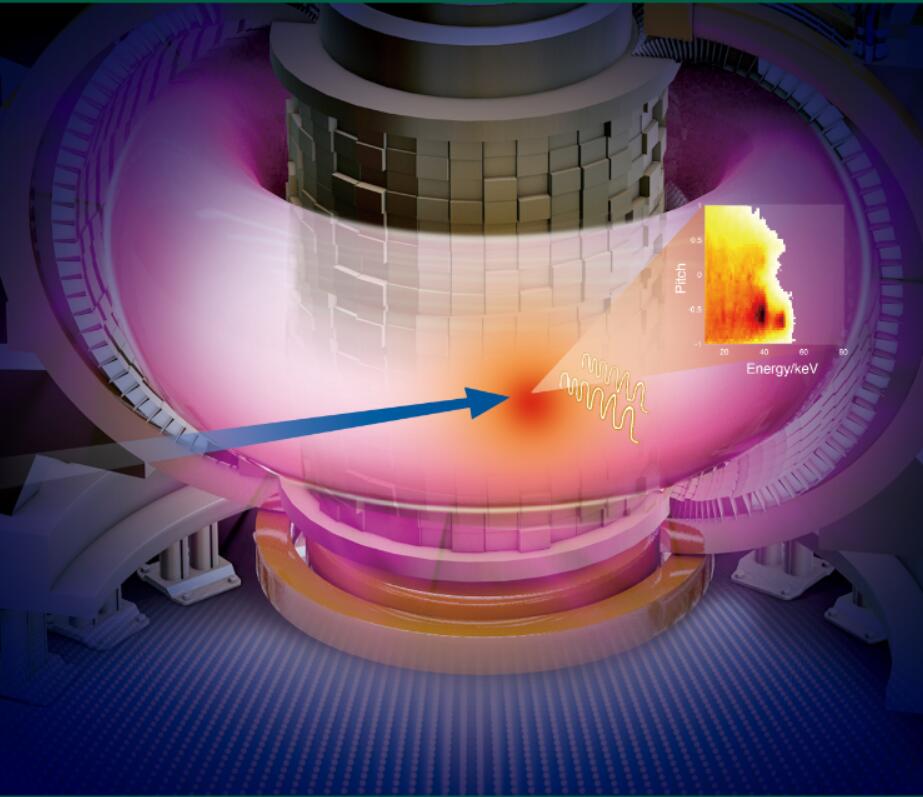INVITED REVIEW

EDITOR'S SUGGESTION
2023, 72 (21): 218701.
doi: 10.7498/aps.72.20231089
Abstract +
Gene transcription regulation is a key step for gene expression in all organisms and responsible for the transmission of genetic information and genome integrity. As one of the most important mechanisms in gene transcription, an RNA polymerase (RNAP) specifically interacts with and unwinds genome DNA to form a transcription bubble where a nascent RNA transcript is polymerized, taking one of the unwound DNA strands as its template. The RNAP translocates along the DNA to transcribe the whole gene by carrying the transcription bubble. In such a way, an RNAP completes its biological task of gene expression by physically acting as a molecular machinery. Thus, an RNAP molecule can be considered as a research object for physicists who are willing to uncover the mechanisms of life processes in a physical view. To achieve this, single-molecule method has been invented and used widely. As one of these methods, single-molecule magnetic trapping manipulates biological molecules by applying extension force or torque to the magnetic beads tethered through biological molecule to pre-coated glass surfaces by manipulating the position or rotation of a pair of magnets. A linear DNA molecule can be manipulated in such a way to generate plectonemes, i.e. DNA supercoils, under an extension force of 0.3 pN (1 pN = 10–12 N), possessing the feature that the number of unwound base pairs of a supercoiled DNA can be observed by the changes in the number of supercoils reflected by the DNA extension changes. Thus, the DNA unwound by RNAP, i.e. the transcription bubble, during transcription can be observed in this way. By monitoring the kinetics of the transcription bubble in real time, this method thus allows single-molecule detection with single-base resolution and a high-throughput data collection fashion in the kinetic studies of transcription. Owing to the advantages of the manipulation of DNA supercoils with single-molecule magnetic trapping, one can mimic the mechanistic feature of DNAs in vivo and characterize the kinetics of transcription under such conditions. This method can also be combined with single-molecule fluorescence method which can be applied to studying the mechanism of transcription regulation while monitoring the behaviors of fluorescently labeled biological molecules that interact with functional RNAP molecules, providing examples for studying the mechanisms of transcription regulations in more complex systems.
SPECIAL TOPIC—Energetic particles in magnetic confinement fusion plasma
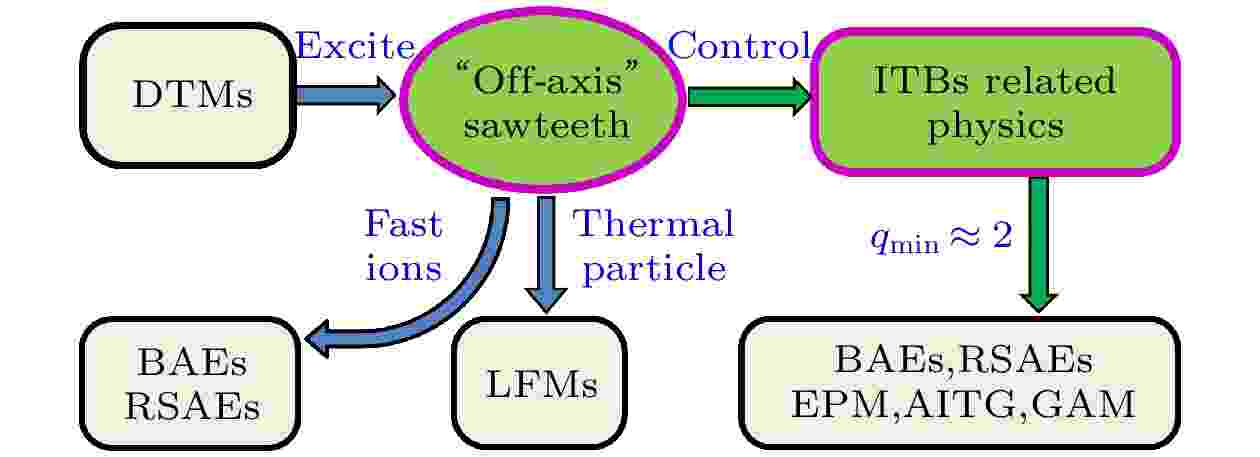
2023, 72 (21): 215204.
doi: 10.7498/aps.72.20230721
Abstract +
Establishment and sustainment of the structure of internal transport barriers (ITBs) is an important guarantee for the magnetic fusion plasma. The related physics processes for the establishing and sustaining of ITBs with $q_{{\rm{min}}} \approx 2$ are simply summarized as follows: the “off-axis sawteeth” (OAS) mode instability and double tearing mode (DTM) instability, fast ions induced Alfvén eigenmode instability, thermal pressure gradient induced low-frequency modes (LFMs) instability, etc. Firstly, the burst of OAS is an important criterion for evaluating reversed q-profile with $q_{{\rm{min}}} \approx 2$ . The excitation conditions, classifications and the structures of precursor modes of OAS are given in detail, and the collapse event is triggered off by the magnetic reconnection of m/n = 2/1 DTM. Secondly, the beta-induced Alfvén eigenmode and reversed shear Alfvén eigenmode are easily excited by the fast ions during the oscillation of OAS. The toroidal mode numbers of the two kinds of Alfvén waves are $1 \leqslant n \leqslant 5$ , respectively, which are located at $1.98\ {\rm{m}} \leqslant R \leqslant 2.07\ {\rm{m}}$ with normalized minor radius $0.2 \leqslant \rho \leqslant 0.45$ . The excitation conditions are investigated for the condition of $q_{{\rm{min}}} \approx 2$ , and three different physical variables, i.e. thermal pressure gradient, fast ions distribution function, and the toroidal flow or flow shear are considered. Thirdly, the LFMs instabilities are excited by the pressure gradient during the oscillation of OAS. The general fishbone-like dispersion relationship (GFLDR) is adopted for solving the basic features of LFMs: 1) the frequency of LFMs scales with ion diamagnetic frequency; 2) the LFMs has the Alfvén polarization direction; 3) the LFMs are a reactive-type kinetic ballooning mode. The excitation of LFMs does not depend on the fast ions, which is taken place in a higher pressure gradient regime $\alpha \propto (1 + \tau) $ $ (1 + \eta_{\rm{i}})$ , $\tau = T_{\rm{e}}/T_{\rm{i}}$ , $\eta_{\rm{i}} = L_{n_{\rm{i}}}/ L_{T_{\rm{i}}}$ . In the end, the suppression of OAS and establishment of ITBs are achieved. Three important processes appear under the condition of $q_{{\rm{min}}} \approx 2$ in EAST: 1) the tangential injection (NBI1L) of NBI is easier for the suppression of OAS than the perpendicular injection (NBI1R); 2) the micro-instability can be suppressed during the oscillation of OAS, and the reversed shear q-profile is more favorable in the establishment of the structure of ITBs; 3) the establishment of ITBs is accompanied by the excitation of Alfvén wave instability (bigger toroidal mode number: $1 \leqslant n \leqslant 5$ ), the sustainment of ITBs is accompanied by the thermal ion temperature gradient induced instability (median size: $5 \leqslant n \leqslant 10$ ). Therefore, for the establishment of ITBs, it is important to understand the establishment and suppression of OAS, the excitation of Alfvén wave instability and the redistributed fast ions, and the related instability of thermal pressure gradient.
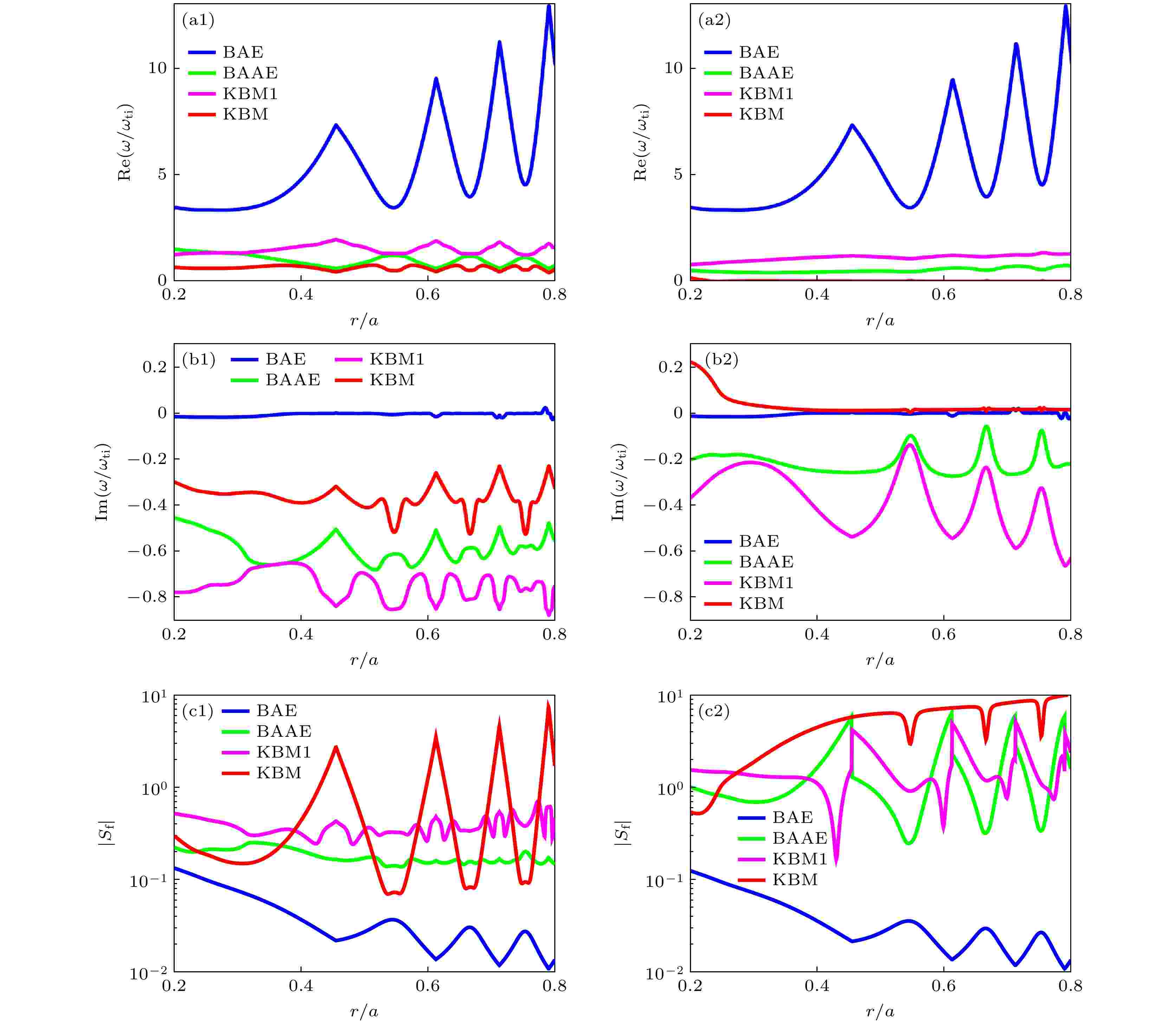
2023, 72 (21): 215207.
doi: 10.7498/aps.72.20230255
Abstract +
The low-frequency Alfvénic fluctuations in the kinetic thermal-ion gap frequency range have aroused the interest of researchers since they can interact with background thermal particles and/or energetic particles. In the theoretical framework of the general fishbone-like dispersion relation (GFLDR), we theoretically investigate and delineate the linear wave properties of the low-frequency shear Alfvén wave excited by energetic and/or thermal particles observed in tokamak experiments with reversed magnetic shear. These low-frequency shear Alfvén waves are closely related to the dedicated experiment on energetic ion-driven low-frequency instabilities conducted on DIII-D in 2019. Therefore, adopting the representative experimental equilibrium parameters of DIII-D, in this work we demonstrate that the experimentally observed low-frequency modes and beta-induced Alfvén eigenmodes (BAEs) are, respectively, the reactive-type unstable mode and dissipative-type unstable mode, each with dominant Alfvénic polarization, thus the former being more precisely called low-frequency Alfvén modes (LFAMs). More specifically, due to diamagnetic and trapped particle effects, the LFAM can be coupled with the beta-induced Alfvén-acoustic mode (BAAE) in the low-frequency range (frequency much less than the thermal-ion transit frequency and/or bounce frequency), or with the BAE in the high frequency range (frequency higher than or comparable to the thermal-ion transit frequency), resulting in reactive-type instabilities. Moreover, due to different instability mechanisms, the maximal drive of BAEs occurs in comparison with LFAMs, when the minimum of the safety factor ($ q_{\rm min} $ ) deviates from a rational number. Meanwhile, the BAE eigenfunction peaks at the radial position of the maximum energetic particle pressure gradient, resulting in a large deviation from the $ q_{\rm min} $ surface. The ascending frequency spectrum patterns of the experimentally observed BAEs and LFAMs can be theoretically reproduced by varying $ q_{\rm min} $ , and they can also be well explained based on the GFLDR. In particular, it is confirmed that the stability of the BAAE is not affected by energetic ions, which is consistent with the first-principle-based theory predictions and simulation results. The present analysis illustrates the solid predictive capability of the GFLDR and its practical applications in enhancing the ability to explain experimental and numerical simulation results.

2023, 72 (21): 215201.
doi: 10.7498/aps.72.20230482
Abstract +
In magnetic confinement fusion plasmas, radio-frequency wave heating in the ion cyclotron range of frequencies (ICRF) and neutral beam injection (NBI) are two main heating methods. Their synergetic heating has long been a key topic in fusion research. In this work, we clarify the basic principles of ICRF high harmonic heating and the synergetic heating between ICRF and NBI. Then, we perform a series of experiments on EAST tokamak and carry out the corresponding TRANSP simulations. The results indicate that the ICRF-NBI synergetic heating not only significantly increases the plasma parameters (including poloidal beta, plasma stored energy, ion temperature and neutron yield), but also generates a large number of energetic particles and develops an energetic particle tail in its distribution function. For instance, the ICRF third harmonic heating with 1 MW of power can increase the energy of NBI fast ions from 60 to 600 keV. By changing the hydrogen minority concentration, improving the ICRF and NBI heating power, using the on-axis ICRF heating or optimizing the NBI injection angle, the ICRF-NBI synergetic heating effect can be further enhanced, accompanied with an increase of fast ion energy. Moreover, by using the fast ion distribution as input in the orbit tracing code, the transport and loss of energetic particles are calculated. The results show that the initial positions of the lost energetic particles are on the low field side, and their orbits are mainly trapped orbits. The loss of energetic particles is mainly located in the middle and upper plane of the main limiter, ICRF and LH antenna limiters. The lost of these energetic particles are considered as one of the main reasons why hot spots occur on the limiters.
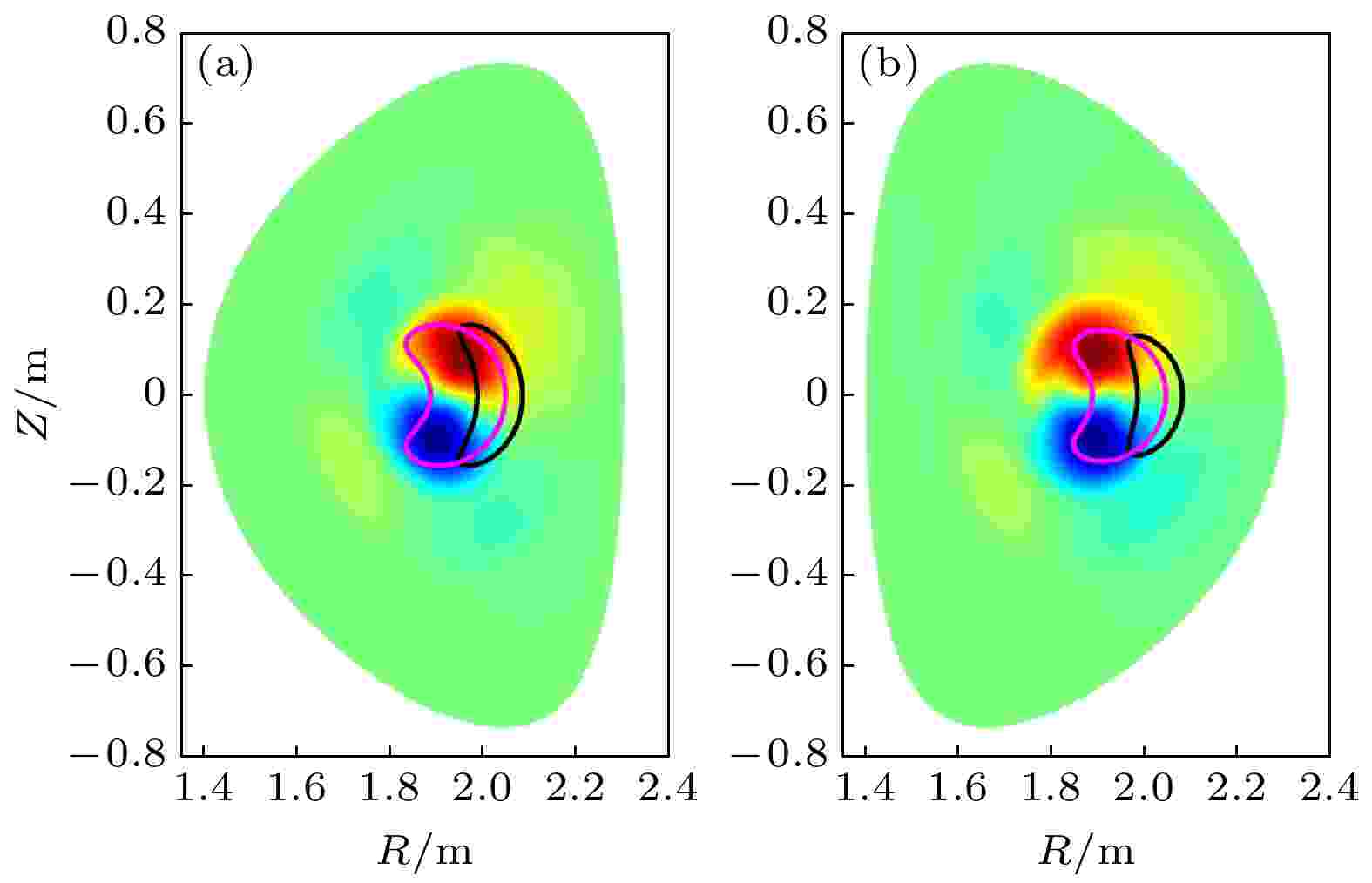
2023, 72 (21): 215202.
doi: 10.7498/aps.72.20230650
Abstract +
The discharges with negative triangularity have lower turbulence induced transport and better energy confinement, so the tokamak with negative triangularity is recognized to be a better choice for future fusion device. In order to explore the features of the energetic particle driven instabilities with negative triangularity, the kinetic-magnetohydrodynamic hybrid code M3D-K is used to investigate the linear instability and nonlinear evolution of the fishbone driven by energetic ions with different triangularity. Based on EAST-like parameters, it is found that the negative triangularity destabilizes the ideal internal kink mode, but stabilizes the fishbone instability. Nonlinear simulations show that the fishbone instability with negative triangularity is hard to saturate without fluid nonlinearity. The possible explanation is that the orbits of fast ions are located more centrally with negative triagularity, so the energy exchange between energetic ions and the fishbone is more efficient than that with positive triangularity. These simulation results demonstrate that the negative triangularity does not have an obvious advantage over the positive triangularity, with the fishbone driven by energetic particles considered.
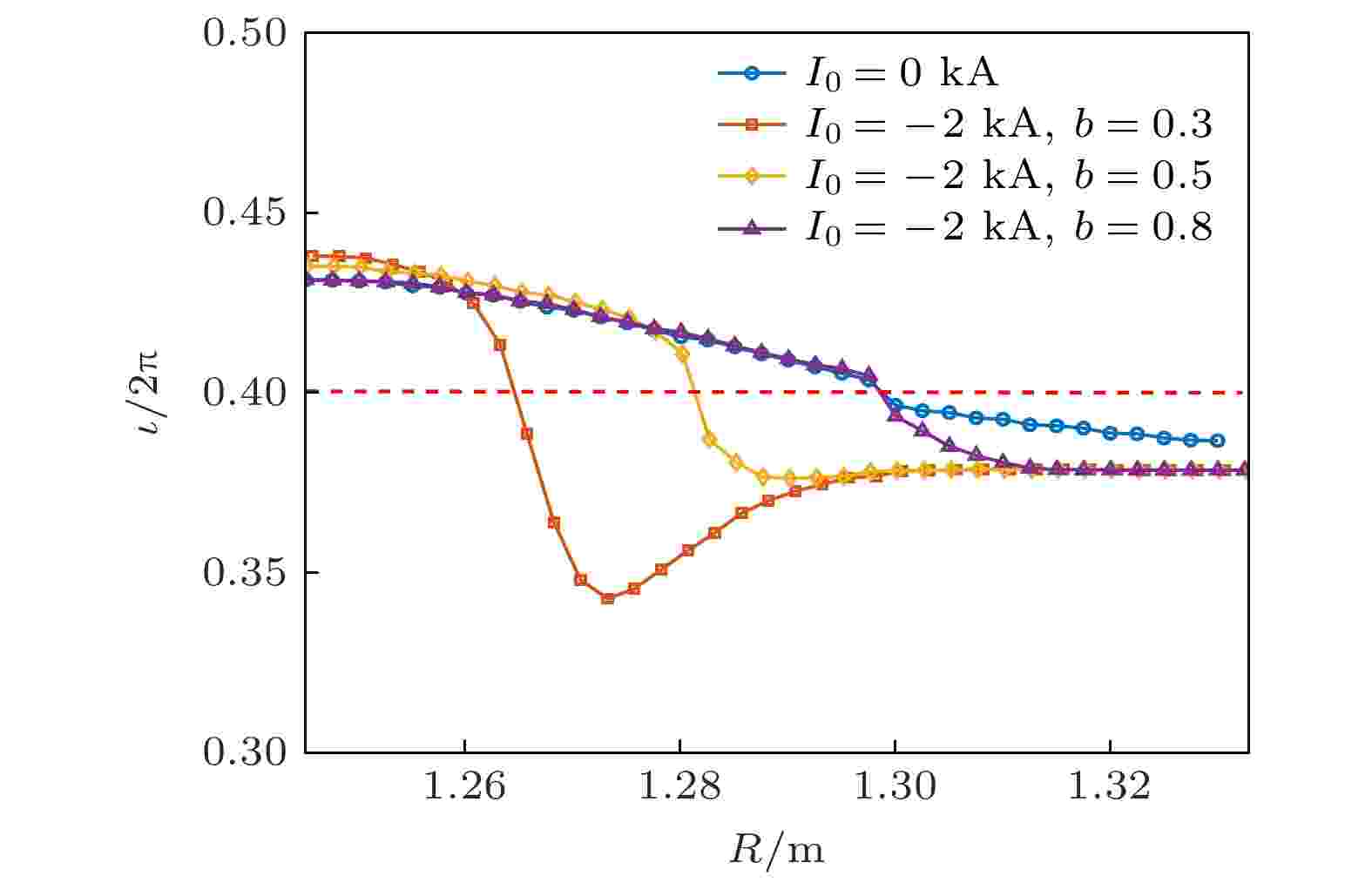
2023, 72 (21): 215205.
doi: 10.7498/aps.72.20230546
Abstract +
Magnetic island produced in toroidal magnetic confinement plasma has a three-dimensional helical structure because of the rotational transform, especially the equilibrium magnetic surface of the stellarator is three-dimensional helical structure. Thus, the formation and instability of the magnetic island of the Stellarator is a typical issue of the three-dimensional physics and is also one of the key topics of the physics research of the Stellarator. Magnetic islands and related tearing mode physics are major issues in stellarator. The non-inductively current drive, i.e. electron cyclotron current drive (ECCD) can be used as one of the approaches to adjusting the rotational transform, and hence, affecting the generation of magnetic islands. In this study, we use an additional toroidal magnetic field to generate m/n = 5/2 magnetic islands in the low-β operation on the Chinese First Quasi-axisymmetric Stellarator (CFQS) so that the influence of the bootstrap current is negligible. Then, we investigate the suppression mechanism of magnetic islands in low-β plasma by using the HINT code. It is found that in the case of the constant current, when the current direction is positive, with the increase of current, the width of island increases. When the direction of current is reversed, the island is suppressed when the current is larger than 6 kA. The main reason is that the rotational transform is away from ι/2π = 0.4 rational surface and the m/n=5/2 magnetic island does not meet the resonance conditions. In the case of local current profile, the magnetic island width decreases as a result of the enhanced magnetic shear at ι/2π = 0.4 rational surface. Moreover, effects of the direction and the amplitude of the current on the suppression of magnetic islands are also discussed in more detail.

2023, 72 (21): 215206.
doi: 10.7498/aps.72.20230681
Abstract +
Based on the critical gradient model , the combination of the TGLFEP code and EPtran code is employed to predict energetic particle (EP) transport induced by Alfvén eigenmodes (AEs). To be consistent with the experimental results, the model was improved recently by taking into consideration the threshold evolution and orbit loss mechanism. The threshold is modified to be the normalized critical gradient ((dn/dr)/(n/a)) instead of the critical gradient (dn/dr), and the new threshold is defined as a function inversely proportional to the EP density as obtained by the TGLFEP code. Additionally, the EP loss cone calculated by ORBIT is added into the EPtran code, which provides an important additional core loss channel for EPs due to finite orbits. With these two improvements, the EP redistribution profiles are found to very well reproduce the experimental profiles of two DIII-D validation cases (#142111 and #153071) with multiple unstable AEs and large-scale EP transport. In addition, a neural network is established to replace TGLFEP for critical gradient calculation, and EPtran code is rewritten with parallel computing. Based on this, a module of EP is established and it is added into the integrated simulation of OMFIT framework. The integrated simulation of HL-3 with AE transported neutral beam EP profile indicates that EP transport reduces the total pressure and current as expected, but under some condition it could also raise the safety factor in the core.
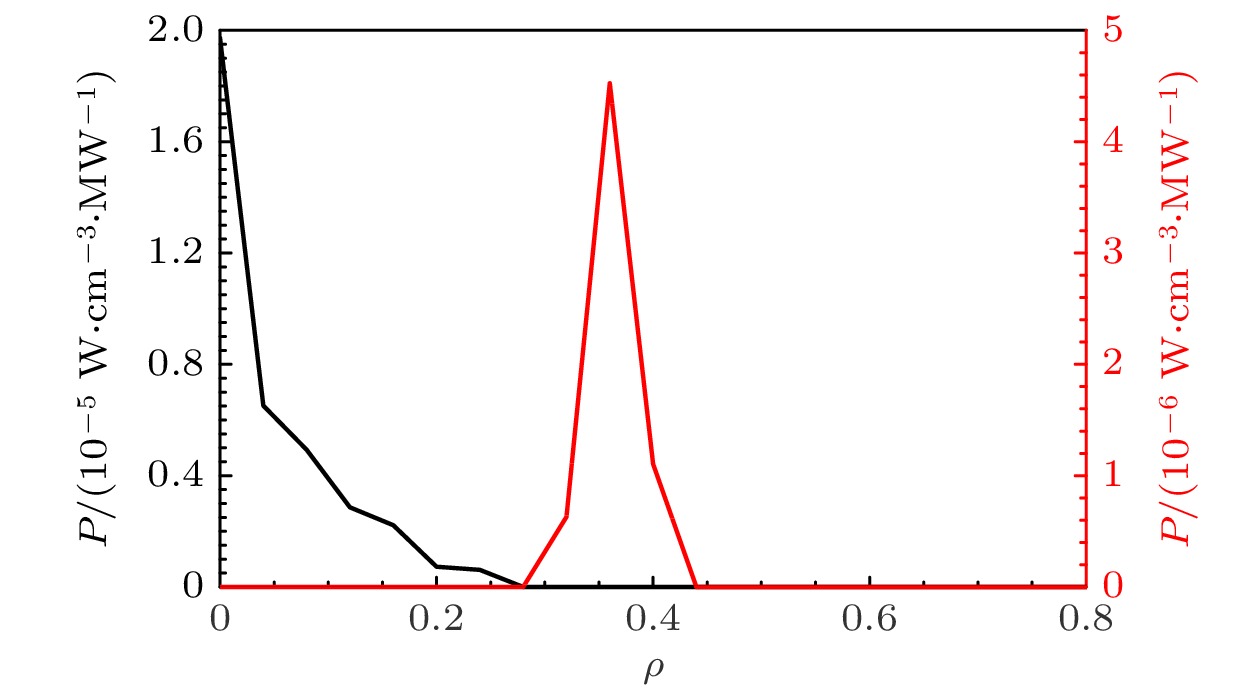
2023, 72 (21): 215208.
doi: 10.7498/aps.72.20230696
Abstract +
Experiment on suppressing fishbone activities is carried out in HL-2A tokamak by electron cyclotron resonance heating (ECRH). To achieve multiple deposition locations of ECRH, the magnetic field is in a range of 1.22–1.4 T from shot to shot. It is found that the fishbone modes exhibit different characteristics at different radial deposition locations. With the same injected power, the effect of off-axis ECRH is much better than that of on-axis heating. The fishbone modes can be completely suppressed when ECRH is deposited nearby the q = 1 rational surface, but would only mitigate in other cases. Further analysis indicate that injection of high power ECRH leads the electron temperature to increase, then the pressure gradient and plasma current density to change, finally safety factor to change and the minimum safety factor to reach a value larger than 1. Meanwhile, M3D-K simulation results show that the growth rate of fishbone mode declines with the increase of qmin. In other words, the growth of safety factor and disappearance of q = 1 rational surface induced by ECRH contribute to the suppression of fishbone activities. The experimental results reported here may not only help to better understand complex effects of ECRH on magnetohydrodynamic instability, but also provide a physics basis for actively controlling the energetic particle driven modes in the future magnetic confined fusion devices.

2023, 72 (21): 215209.
doi: 10.7498/aps.72.20230700
Abstract +
The high-energy α particles produced by deuterium-tritium fusion are the primary heating source for maintaining high temperatures in future tokamak plasma. Effective confinement of α particles is crucial for sustaining steady-state burning plasma. The initial energy of α particles is $ 3.5 {\text{ MeV}} $ . According to theoretical calculations, it takes approximately 1 second to slow down α particles through Coulomb collisions to an energy range similar to the energy range of the background plasma. In the slowing-down process, some α particles may be lost owing to various transport processes. One significant research problem is how to utilize α particles to effectively heat fuel ions so as to sustain fusion reactions in a reactor. Assuming local Coulomb collisions and neglecting orbital effects, a classical slowing-down distribution for α particles can be derived. However, considering the substantial drift orbit width of α particles and the importance of spatial transport, numerical calculations are required to obtain more accurate α particle distribution function. In this study, the particle tracer code (PTC) is used to numerically simulate the slowing-down process of α particles under different scenarios in the Chinese Fusion Engineering Test Reactor (CFETR). By combining particle orbit tracing method with Monte Carlo collision method, a more realistic α particle distribution function can be obtained and compared with the classical slowing-down distribution. The results show significant differences between this distribution function and the classical slowing-down distribution, particularly in the moderate energy range. Further analysis indicates that these disparities are primarily caused by the strong radial transport of α particles at these energy levels. The research findings hold profound implications for the precise evaluating of ability of α particles to heat the background plasma. Understanding and characterizing the behavior of α particles in the slowing-down process and their interaction with the plasma is critical for designing and optimizing future fusion reactors. By attaining a deeper comprehension of the spatial transport and distribution of α particles, it becomes possible to enhance the efficiency of fuel ion heating and sustain fusion reactions more effectively. This study establishes a foundation for subsequent investigations and evaluation of α particles as a highly efficient heating source for fusion plasmas.
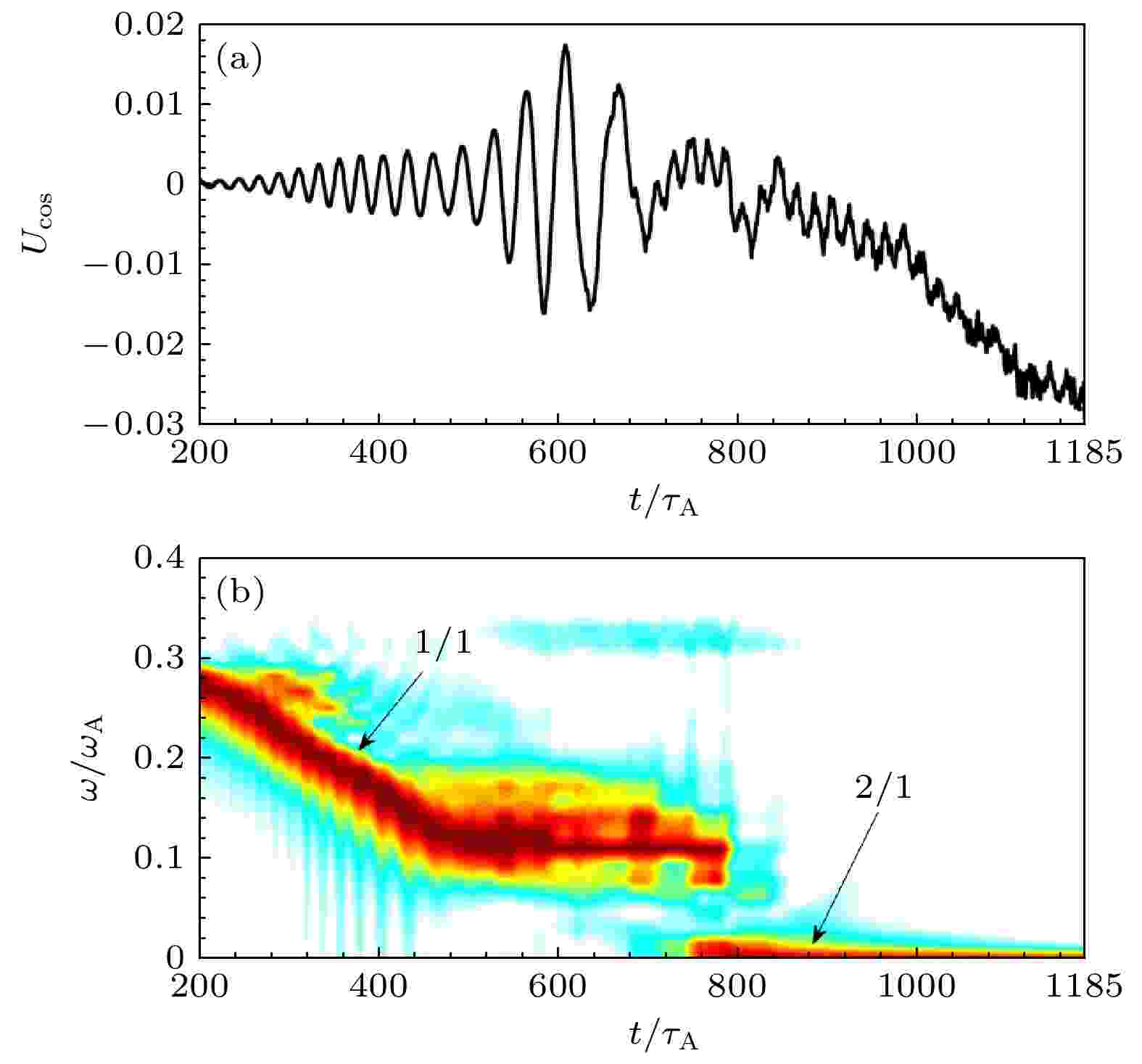
2023, 72 (21): 215210.
doi: 10.7498/aps.72.20230620
Abstract +
In tokamak experiments, various magnetohydrodynamic (MHD) instabilities usually co-exist and interact with fast particles. It can cause the fast particles to significantly transport and lose, which results in damaging the first wall and quenching discharge in tokamak. Therefore, the understanding of the physical mechanism of fast particle transport caused by MHD instabilities is crucial and this physical problem needs solving urgently for the steady-state long pulse operation of future reactor-graded devices. According to the phenomenon of synergy between non-resonant internal kink mode and tearing mode, observed experimentally on NSTX, a spherical tokamak device, we utilize the global nonlinear hybrid-kinetic simulation code M3D-K to study and compare the characteristics of loss, transport and redistribution of fast particles in the two cases: 1) the synergy between the non-resonant internal kink mode and tearing mode and 2) only non-resonant internal kink modes. The physical mechanisms of transport, loss, and redistribution of fast particles caused by such synergy are studied, respectively. The results show that the synergy between the non-resonant internal kink mode and the tearing mode can significantly enhance the loss and transport of fast particles. The main reason is that such a synergy can provide a radial channel for fast particles to migrate from the plasma core to the plasma boundary accompanied with the total stochasticity of the magnetic topology. These results can help understand the physical mechanism of the transport and loss of fast particles caused by the synergy of low-frequency MHD instabilities in future fusion reactors, and provide some new ideas for finding strategies to control and mitigate the loss and transport level of fast particles in future fusion reactors.
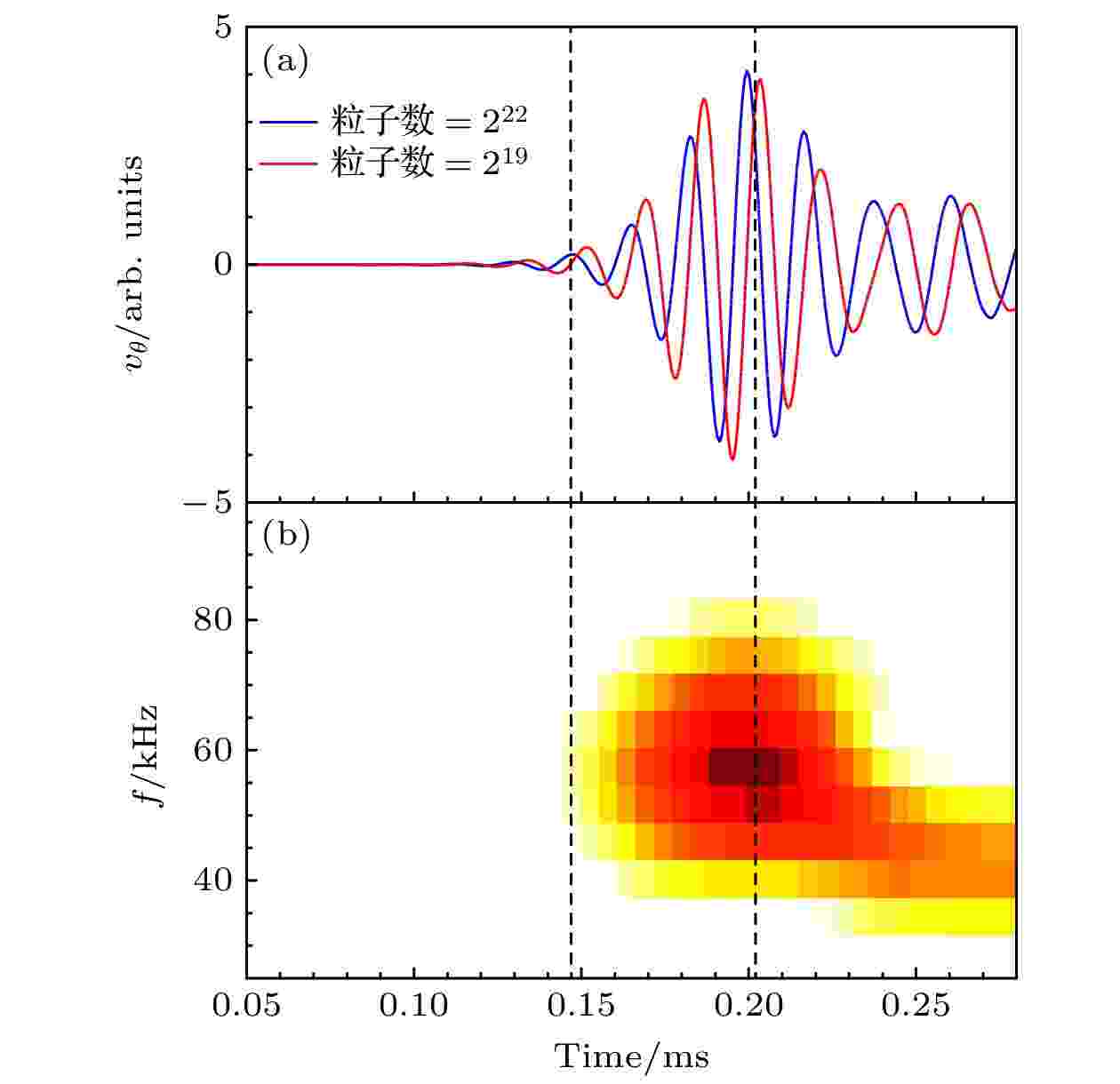
Beta-induced Alfvén eigenmodes with frequency chirping driven by energetic ions in the HL-2A Tokamak
2023, 72 (21): 215211.
doi: 10.7498/aps.72.20230726
Abstract +
The beta-induced Alfvén eigenmodes (BAEs) with frequency chirping, observed in the HL-2A Tokamak, are analysed by a MHD-kinetic hybrid code MEGA. Realistic parameters are applied to the code, such as equilibrium, electron density and temperature, ion temperature, which is different from the kinetic Berk-Breizman theory. The BAEs are observed by Mirnov probes and soft X-ray arrays. Toroidal and porloidal mode number are confirmed to be n/m = 2/3 by using the phase shift method with toroidal filtered Mirnov signal arrays. And the soft X-ray arrays’ signal shows that BAEs are located at the core of the plasma and they have a relatively broad mode structure. The BAEs with up- and down-chirping are reproduced with MEGA code. The simulation results of mode structure accord well with experimental observations. Compared with up-chirping BAEs, the down-chirping BAEs are excited with higher plasma parameters and beta value, thus the energetic ion distribution in pitch angle has a broader width, and the beta value of energetic ions in the core of plasma and diffusion value are higher in the down-chirping simulation. The simulation results show that the phase space distribution of energetic ions affects the wave chirping direction. The energetic ions parallel to the magnetic field drive the up-chirping behavior. When the down-chirping behavior dominates, the density of energetic ions perpendicular to the magnetic field increases significantly. It shows that the down-chirping BAEs require higher beta and energetic ion density, which is consistent with the previous simulation result.
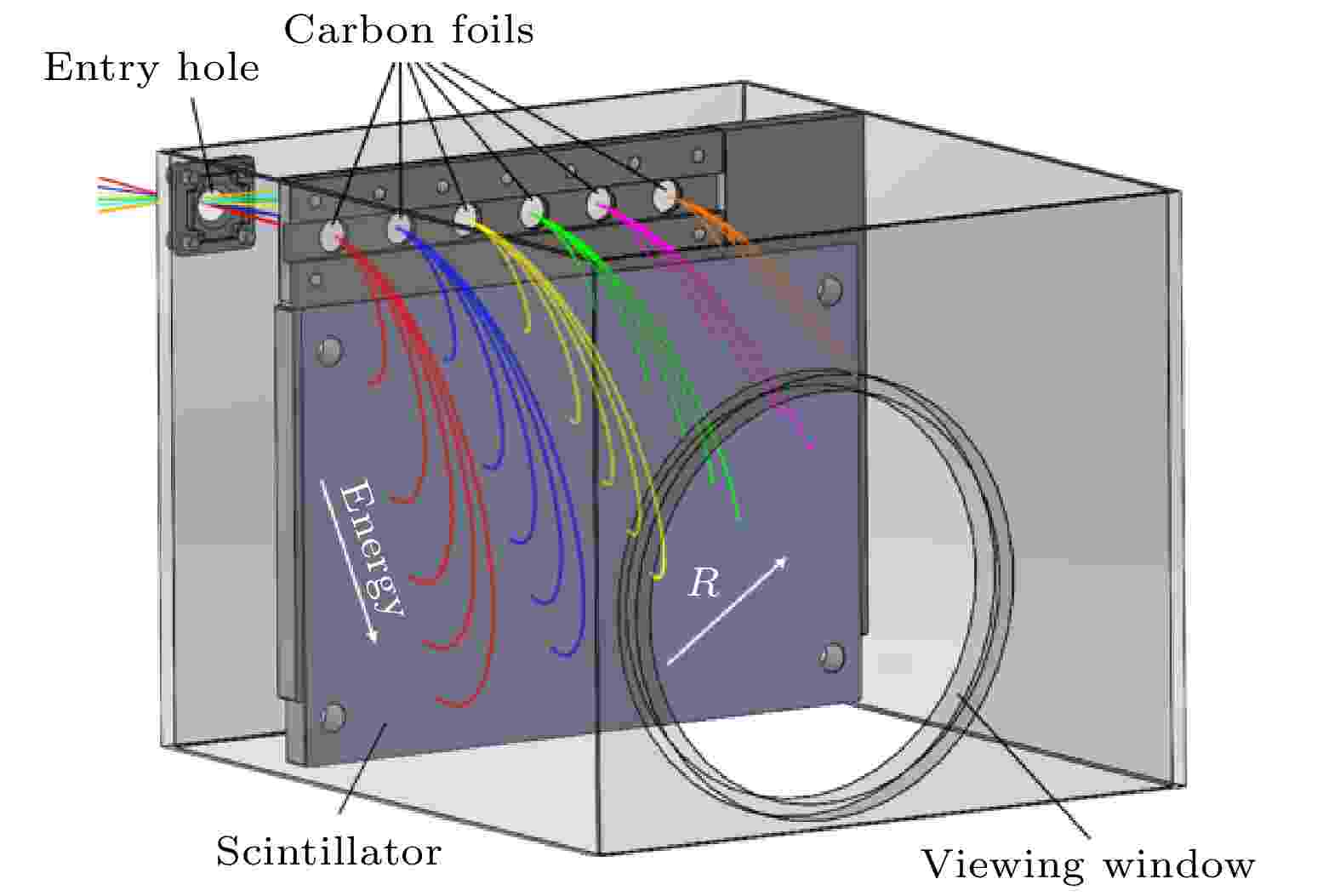
2023, 72 (21): 215212.
doi: 10.7498/aps.72.20230768
Abstract +
The imaging neutral particle analyzer (INPA) based on scintillator (ZnS(Ag)) is designed and used on HL-2A tokamak to investigate the distribution of energetic particles (EPs) and even their interactions with magnetohydrodynamic instabilities. The collimation system is composed of a pinhole of 3 mm in diameter and six circular carbon microcrystal diaphragms each with a thickness of 10 nm. The neutral particles escape from six definite positions in the neutral beam injection path and pass through the collimator system at a certain pitch angle, and the neutral particles become fast ions after passing through the carbon microcrystal diaphragm. The fast ions will hit the scintillator after a 180° deflection by the edge magnetic field. The energy, pitch angle and birthplace can be calculated by the position and light intensity of the impact spots. The images of impact spots caused by long-lived mode are recorded by a high-speed camera through the fiber optic bundle. The long-lived mode instabilities approve to be excited by the core EPs with energy value in a range of $E\sim $ 12.5-32 keV, pitch angle of $v_{//}/v\sim$ 0.86, and the birthplace in a range of $R\sim $ 170.5-171.5 cm.
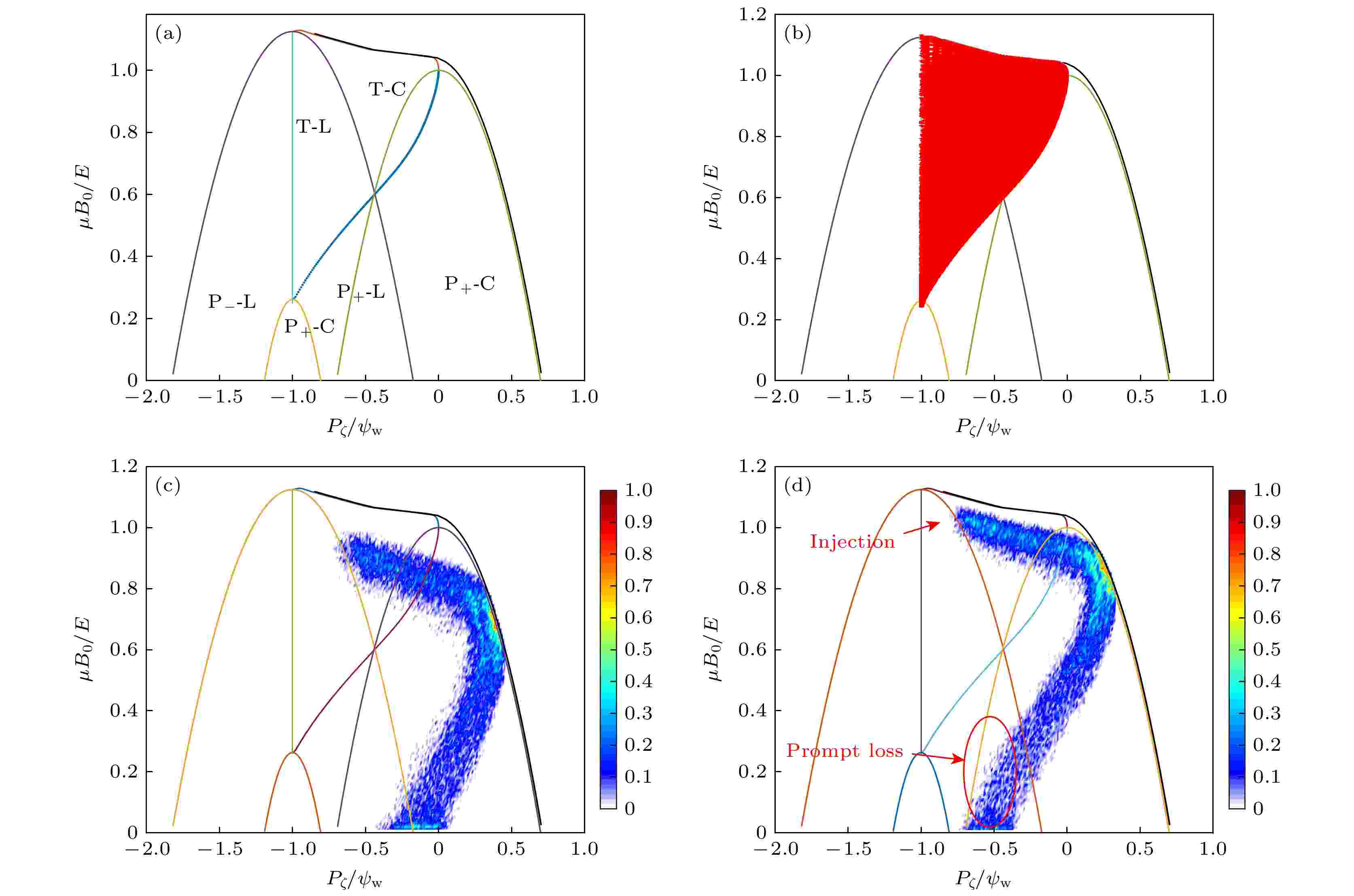
2023, 72 (21): 215215.
doi: 10.7498/aps.72.20230749
Abstract +
Realization of high performance plasma of EXL-50U is very sensitive to NBI (neutral beam injection) heating, and it is expected that the fast ions of NBI are confined well and their energy is transferred to the background plasma by collision moderating. In this paper, the loss of fast ion ripple is simulated based on the equilibrium configuration, fast ion distribution and device waviness data given by the integrated simulation. It is found that the loss fraction of fast ion ripple is about 37%, and the local hot spot is about 0.6 MW/m2, which is unacceptable for the experimental operation of the device. The optimization method includes moving the plasma position and adding FI (ferritic steel plug-in) to reduce the ripple degree, increasing the Ip (plasma current) and optimizing the NBI injection angle. The results show that the ripple distribution must be controlled and the Ip must be increased to more than 600 kA, so that the fast ion loss can be reduced to 3%–4% and the local heat spot can be reduced by an order of magnitude. In this paper, the evaluation methods of fast ion ripple loss in device design are summarized, including the fast ion distribution in phase space, the overlap degree of ripple loss area, and the particle tracking on the time scale of total factor slowing down. The engineering and physical ways to reduce ripple loss are also summarized to provide simulation support for integrated simulation iterative optimization and plant operation.
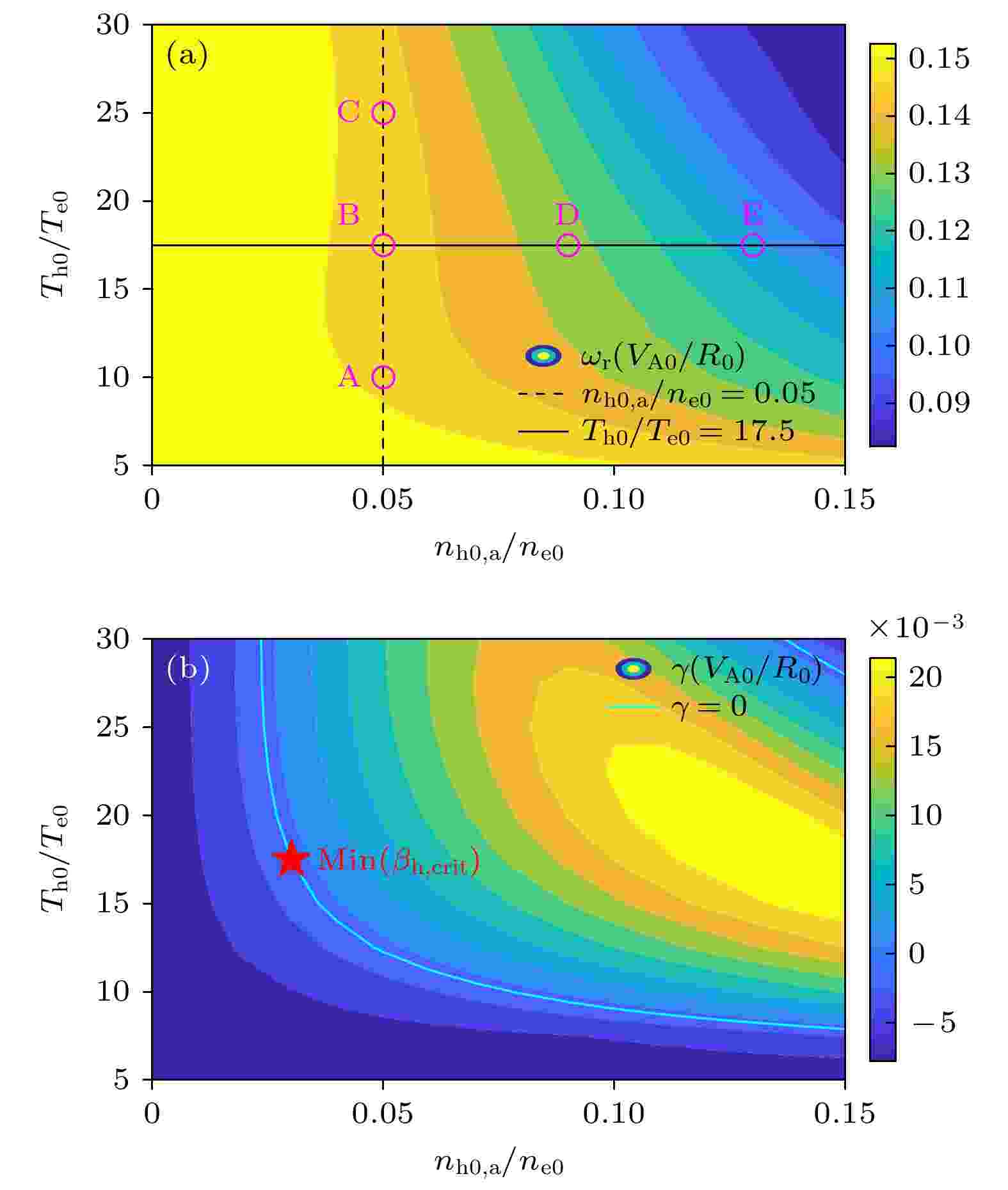
2023, 72 (21): 215216.
doi: 10.7498/aps.72.20230794
Abstract +
The energetic electron (EE) excitation of beta-induced Alfvén eigenmodes is investigated by using the newly developed global eigenvalue code MAS, which is based on a hybrid model that consists of Landau fluid bulk plasma and drift kinetic EE. Specifically, the bulk plasma kinetic effects such as finite Larmor radius, diamagnetic drifts and Landau dampings, and the EE adiabatic fluid response of convection and non-adiabatic kinetic response of precessional drift resonance are incorporated in the simulations. The global eigenmode equation is solved for e-BAE mode structure and linear dispersion relation in tokamak non-perturbatively. The radial width of e-BAE mode structure becomes narrower as the toroidal mode number increases, which can be explained by the change of Alfvén continuous spectra that interact with kinetic Alfvén waves for corresponding eigenmode formation. The e-BAE growth rate exhibits a non-monotonic variation with toroidal mode number for precessional drift resonance destabilization, while the e-BAE real frequency is close to the continuum accumulation point that almost remains the same. The parametric dependence of e-BAE stability on EE density and that on temperature are analyzed by MAS non-perturbative simulations, which shows that the EE density can affect e-BAE real frequency and thus changes the resonance condition, resulting in e-BAE stabilization in the strong EE drive regime. Further, the EE non-perturbative effect on the symmetry breaking of e-BAE mode structure is reported. The poloidal symmetry breaking characterized by the ‘boomerang’ shape two-dimensional (2D) structure can be greatly enhanced by increasing EE temperature, together with the large radial variation of the poloidal phase angle of dominant principal poloidal harmonic. The radial symmetry breaking of e-BAE mode structure arises when EE density/temperature drive is not symmetric with respect to corresponding rational surface, which can lead to a net volume-averaged value of e-BAE parallel wave number which drives plasma intrinsic rotation. These results are helpful in understanding the e-BAE dynamics observed in recent experiments.
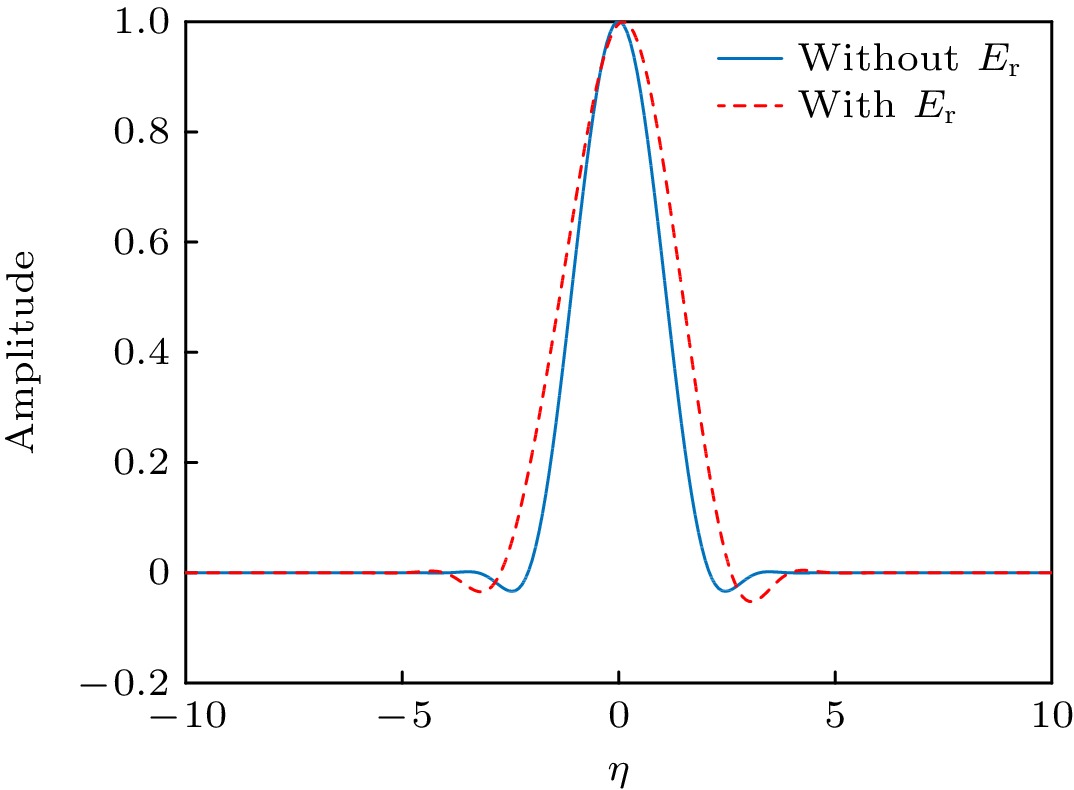
2023, 72 (21): 215217.
doi: 10.7498/aps.72.20230798
Abstract +
To understand the effect of given radial electric field on ion-temperature gradient driven mode (ITG) stability in tokamak plasmas, we derive the eigenmode equation for ITG including the poloidal rotation and density modulation associated with radial electric field by using nonlinear gyrokinetic theory. The equation is solved for the eigenfrequency, growth rate and parallel mode structure of ITG both in short- and long-wavelength limit with energetic-particle-induced geodesic acoustic mode (EGAM) as a specific form. The eigenmode equation is not only solved analytically, but also solved numerically to validate the analytic solutions. It is found that, the radial electric field induced poloidal rotation can significantly stabilize ITG, while the density perturbation of the radial electric field may slightly distort the ITG parallel mode structure, but has little effect on ITG stability. The result is consistent with the common picture of turbulence suppression by poloidal shear flow. The general model is also applicable to the investigation of the indirect interaction of ITG and energetic particle driven Alfvén instabilities via zonal structures generation, by introducing poloidal rotation and density modulation associated with zonal structures spontaneously excited by Alfvén instabilities. The indirect channel is supplement to the direct interaction of microturbulences and energetic particle driven Alfvén instabilities.
SPECIAL TOPIC—Energetic particles in magnetic confinement fusion plasma • COVER ARTICLE
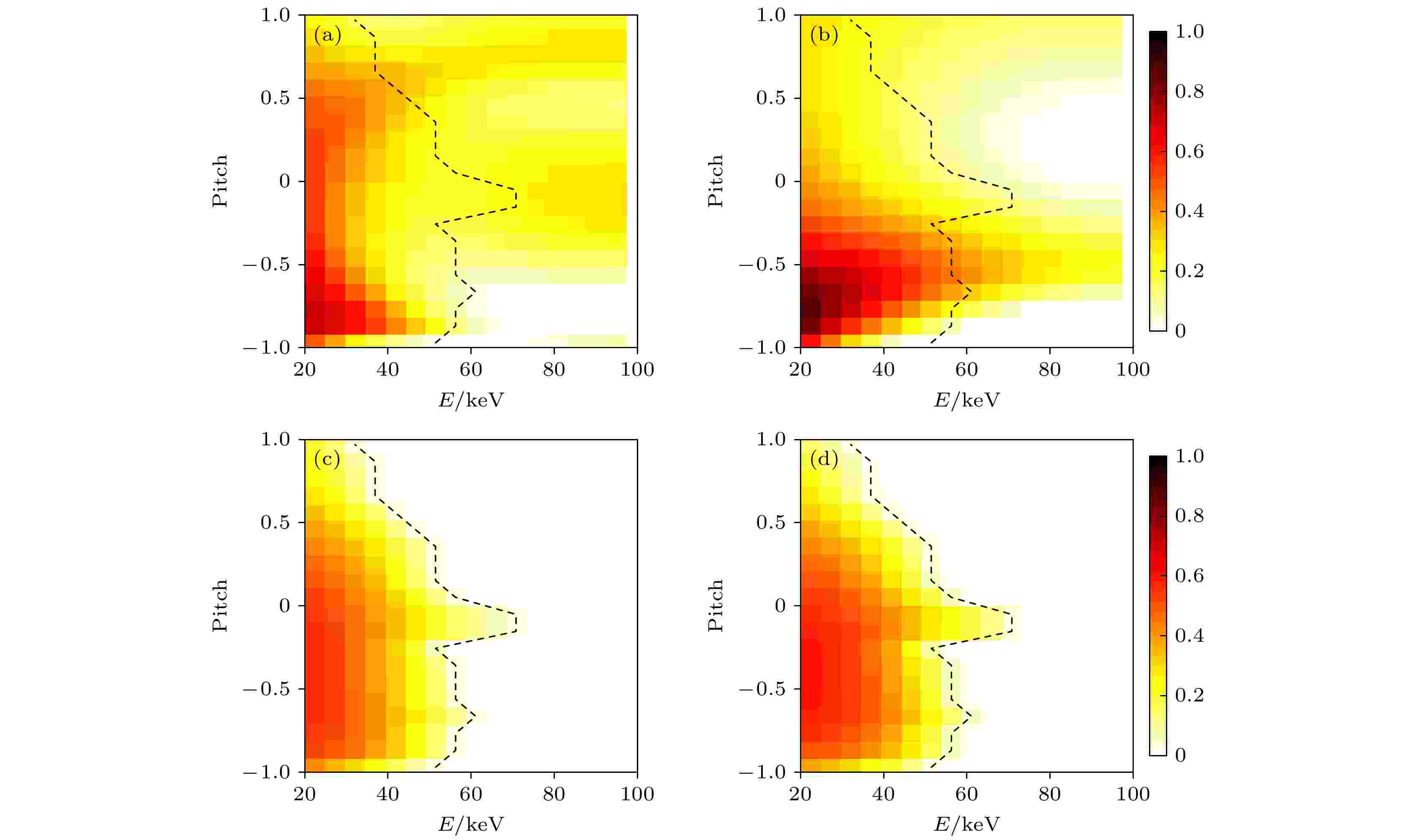
COVER ARTICLE
2023, 72 (21): 215203.
doi: 10.7498/aps.72.20230846
Abstract +
In magnetic confinement fusion devices, velocity-space tomography of fast-ion velocity distribution function is crucial for investigating fast-ion distribution and transport. In the neutral beam injection (NBI) and ion cyclotron resonance heating (ICRF) synergistic heating experiments in Experimental Advanced Superconducting Tokamak (EAST), high-energy particles with energy exceeding the particle energy in NBI are observed. Simulations of synergistic effect on fast-ion velocity distribution function given by TRANSP also show the existence of particles with energy higher than the particle energy in NBI. To investigate the behaviors of fast ion distribution and calculate the velocity distribution functions under different heating conditions, the first-order Tikhonov regularization tomographic inversion method with higher inversion accuracy is introduced by comparing various regularization techniques. The limitations of the dual-view fast-ion Dα (FIDA) diagnostic measurements in velocity space are addressed by incorporating prior information such as null measurement and the known peaks and effectively mitigate the occurrence of artifacts. This method is first employed in the case of NBI heating. The NBI peak is successfully reconstructed at the expected location in velocity space, which shows significant improvement in the inversion results. In order to further validate the synergistic effect of NBI-ICRF heating and study the mechanism of fast ion distribution under synergistic heating, the combination of FIDA and neutron emission spectrometer (NES) is applied to the first-order Tikhonov regularization tomographic inversion method for enhancing the coverage of velocity space, through which the issue of artifacts in the inversion results is significantly improved, and thus the precision of the obtained fast-ion velocity distribution functions is enhanced. Based on the benefit described above, the method of combining NES diagnosis and FIDA diagnosis is used to obtain fast-ion velocity distribution functions in the NBI and ICRF synergistic heating discharge. The synergistic heating effect is manifested in the fast-ion velocity distribution. The availability of this inversion method in reconstructing fast-ion velocity distribution functions during high-performance operation of NBI-ICRF synergistic heating in the EAST experiment is confirmed. In the next-step EAST research, high performance discharge will demand more efficiency NBI and ICRF synergistic heating, the present work builds the stage for investigating the underlying mechanism of synergistic heating and the intricate behaviors associated with fast ion distribution and transport.
SPECIAL TOPIC—The 70th anniversary of National University of Defense Technology

2023, 72 (21): 214207.
doi: 10.7498/aps.72.20231242
Abstract +
As a kind of quantum phenomenon, Hong-Ou-Mandel (HOM) interference is more robust against phase noise. Because of this feature, robust quantum holography emerges, through which wave function of interested photon can be retrieved according to HOM interference pattern. For better understanding and developing this method, we derive a theoretical framework of robust HOM holography. In the quantum holography scheme, test state and reference state interfere at beam splitter (BS). Then, degree of freedom (DOF) resolved detections (such as spatial resolved detection, temporal resolved detection or spectrum resolved detection) are used at the BS output ports, respectively. Based on the single photon detection results, the DOF resolved coincidence counts are postselected, producing interference patterns. The information of the test states is retrieved from the patterns. According to different test states and reference states, four combinations are analysed, including measuring the wave function of single photon state by using standard single photon state or coherent state and measuring the wave function of coherent state through using standard single photon state or coherent state. In all cases, information of the test states is reflected in normalized second-order correlation function or interference patterns in similar forms. Specially, the wave function of test states can be directly retrieved from the interference patterns, with no complex algorithm required. Besides, phase noise from environment has no influence on this kind quantum holography. Comparison between traditional holography and quantum holography is made and analysed.
GENERAL
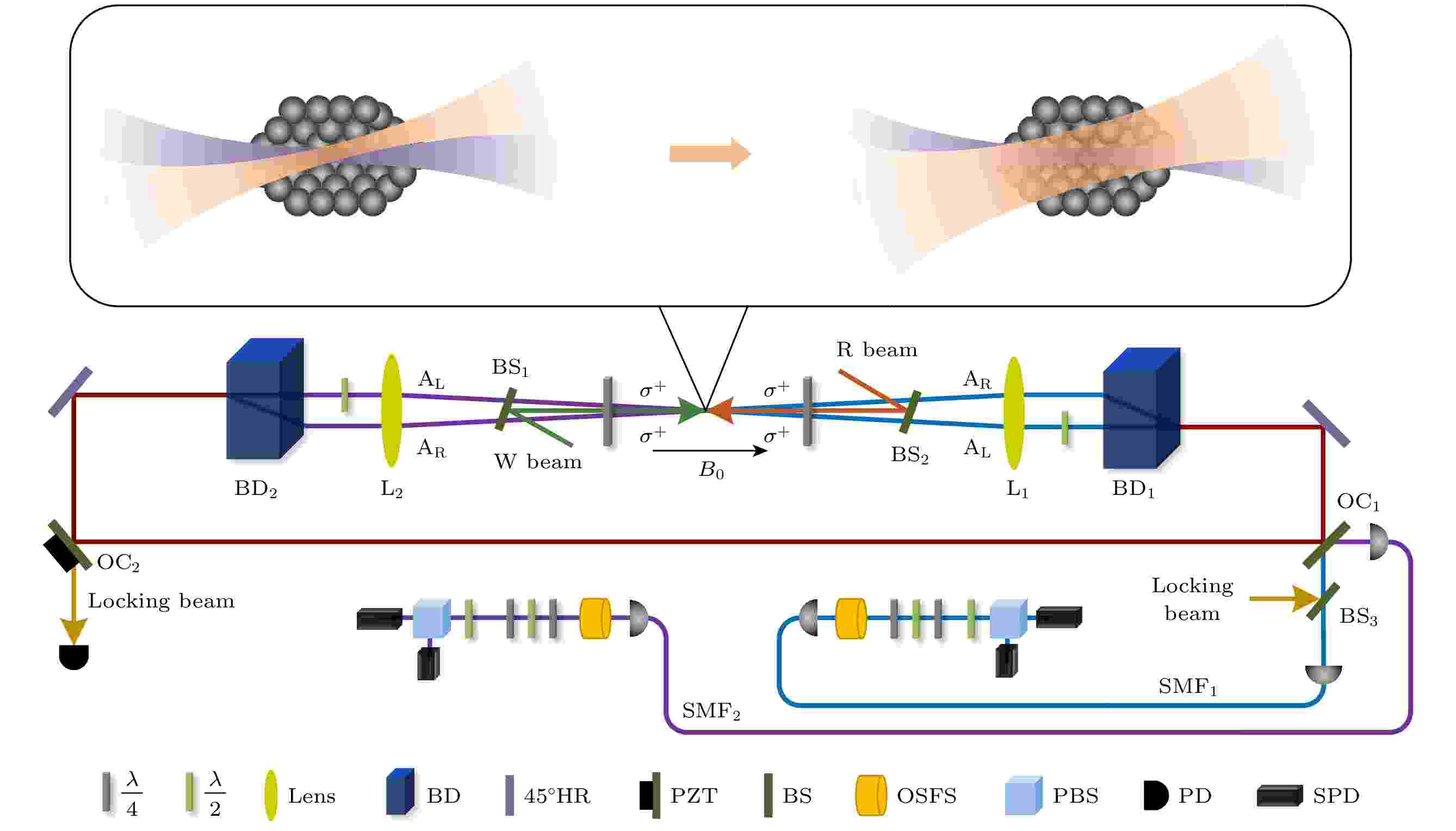
2023, 72 (21): 210301.
doi: 10.7498/aps.72.20230966
Abstract +
ELECTROMAGNETISM, OPTICS, ACOUSTICS, HEAT TRANSFER, CLASSICAL MECHANICS, AND FLUID DYNAMICS
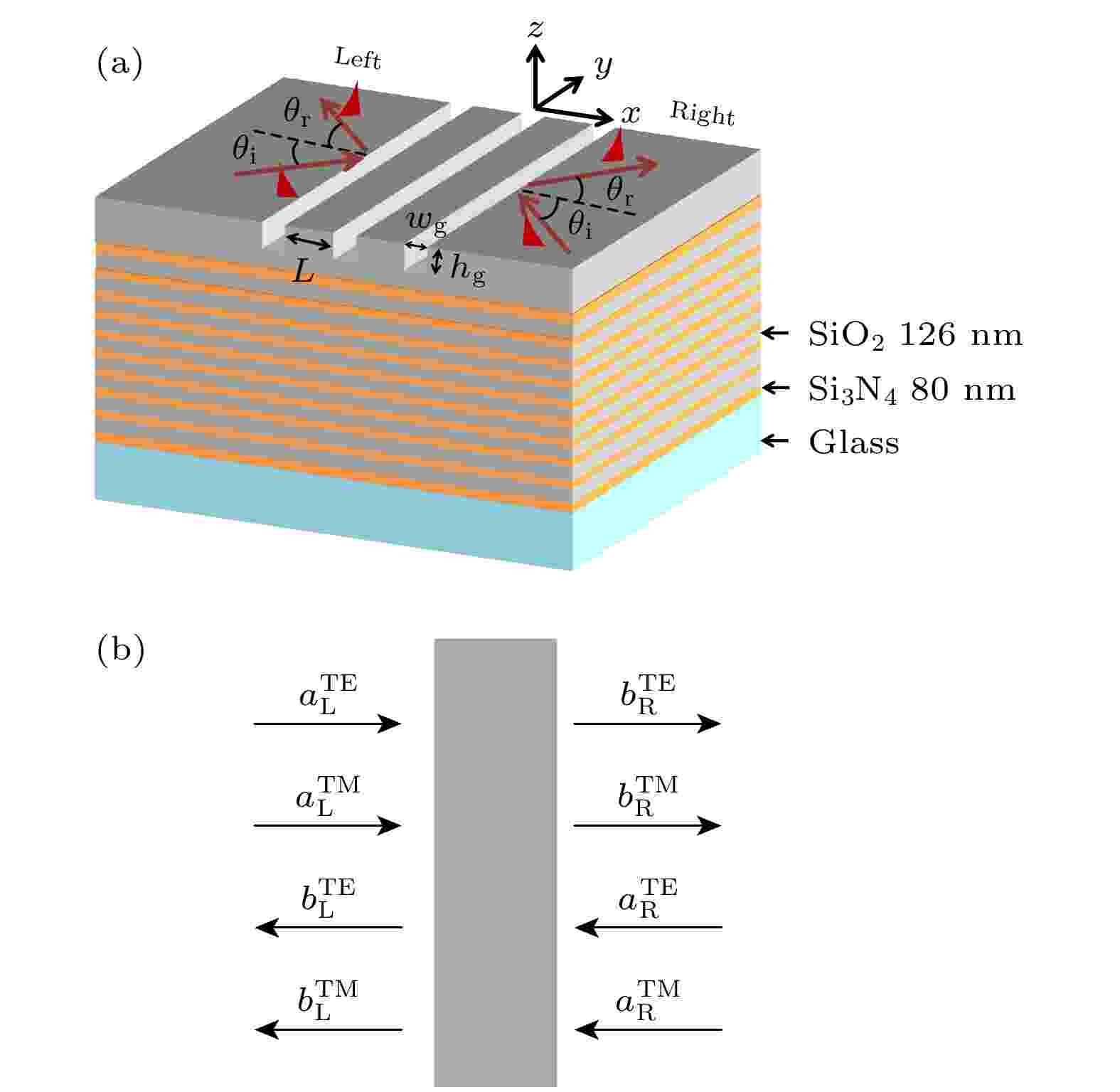
2023, 72 (21): 214201.
doi: 10.7498/aps.72.20231050
Abstract +
The coherent excitation of optical device through the interference effect of multiple beam provides a practical way to enhance the degree of real-time control of the optical response of device. In this work, the coherent control of polarization transformation of Bloch surface wave supported by dielectric multilayer is studied. The grooves are introduced into the top layer of the dielectric multilayer to achieve the polarization transformations of Bloch surface wave. Two coherent beams of Bloch surface waves are incident on the grooves from the left side and the right side of the structure, respectively. The polarization transformation efficiency of Bloch surface wave can be controlled in real time by designing the phase difference of polarization transformation coefficients and the phase delay of the incident coherent beams. Moreover, the output ports of polarization transformation of Bloch surface waves can be selectively excited. By using the proposed method, the controllable port transmission of Bloch surface wave related polarization component can be achieved. In this work, the design of phase difference from the polarization transformation coefficients is achieved by changing the separation distance of grooves. The predicted polarization transformation phenomena under the excitation of coherent beams are evidenced by the rigorous electromagnetic simulation. The research results have potential applications in on-chip integration of photonic circuitry.
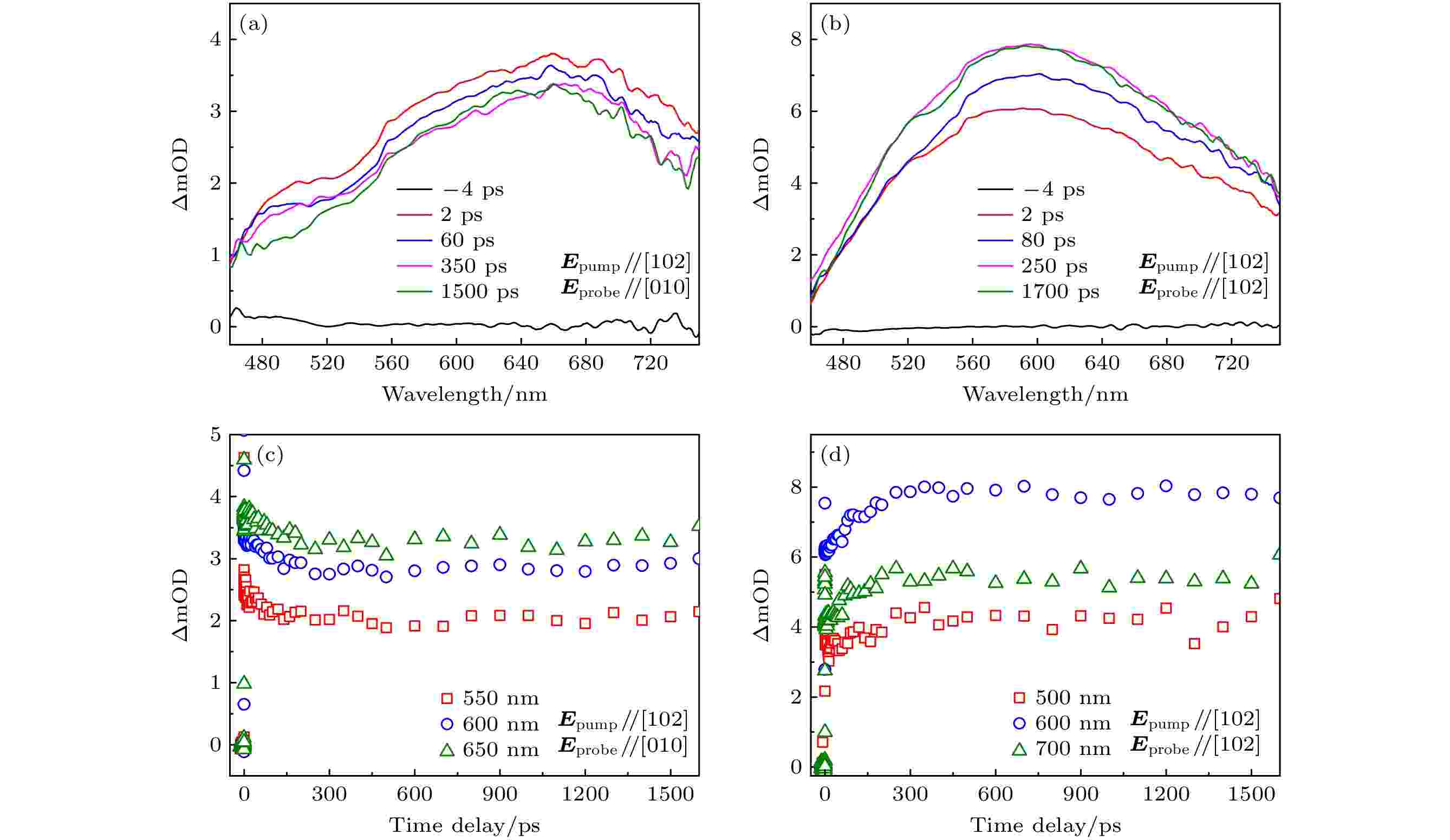
EDITOR'S SUGGESTION
2023, 72 (21): 214202.
doi: 10.7498/aps.72.20231173
Abstract +
The ultra-wide bandgap semiconductor gallium oxide β-Ga2O3 with enhanced resistance to the irradiation and temperature is favorable for high-power and high-temperature optoelectronic devices. β-Ga2O3 also exhibits great potential applications in the field of integrated photonics because of its compatibility with the CMOS technique. However, a variety of intrinsic and extrinsic defects and trap states coexist in β-Ga2O3, including vacancies, interstitials, and impurity atoms. The defect-related carrier dynamics in β-Ga2O3 not only adversely affect the optical and electrical properties, but also directly limit the performance of β-Ga2O3 based devices. Therefore, a comprehensive understanding of the carrier transportation and relaxation dynamics induced by intrinsic defects is very important. Supercontinuum-probe spectroscopy can provide a fruitful information about the carrier relaxation processes in different recombination mechanisms, and thus becomes an effective way to study the defect dynamics. In this work, we study the dynamics of carrier trapping and recombination induced by intrinsic defects in pristine β-Ga2O3 crystal by using wavelength-tunable ultrafast transient absorption spectroscopy. The broadband absorption spectra induced by the intrinsic defects are strongly dependent on the polarization of pump pulse and probe pulse. Particularly, two absorption peaks induced by the two defect states can be extracted from the transient absorption spectra by subtracting the absorption transients under two probe polarizations. The observed defect-induced absorption features are attributed to the optical transitions from the valence band to the different charge states of the intrinsic defects (such as gallium vacancy). The data are well explained by a proposed carrier capture model based on multi-level energies. Moreover, the hole capture rate is found to be much greater than that of the electron, and the absorption cross-section of the defect state is at least 10 times larger than that of free carrier. Our findings not only clarify the relationship between intrinsic defects and photogenerated carrier dynamics, but also show the importance in the application of β-Ga2O3 crystals in ultrafast and broadband photonics.
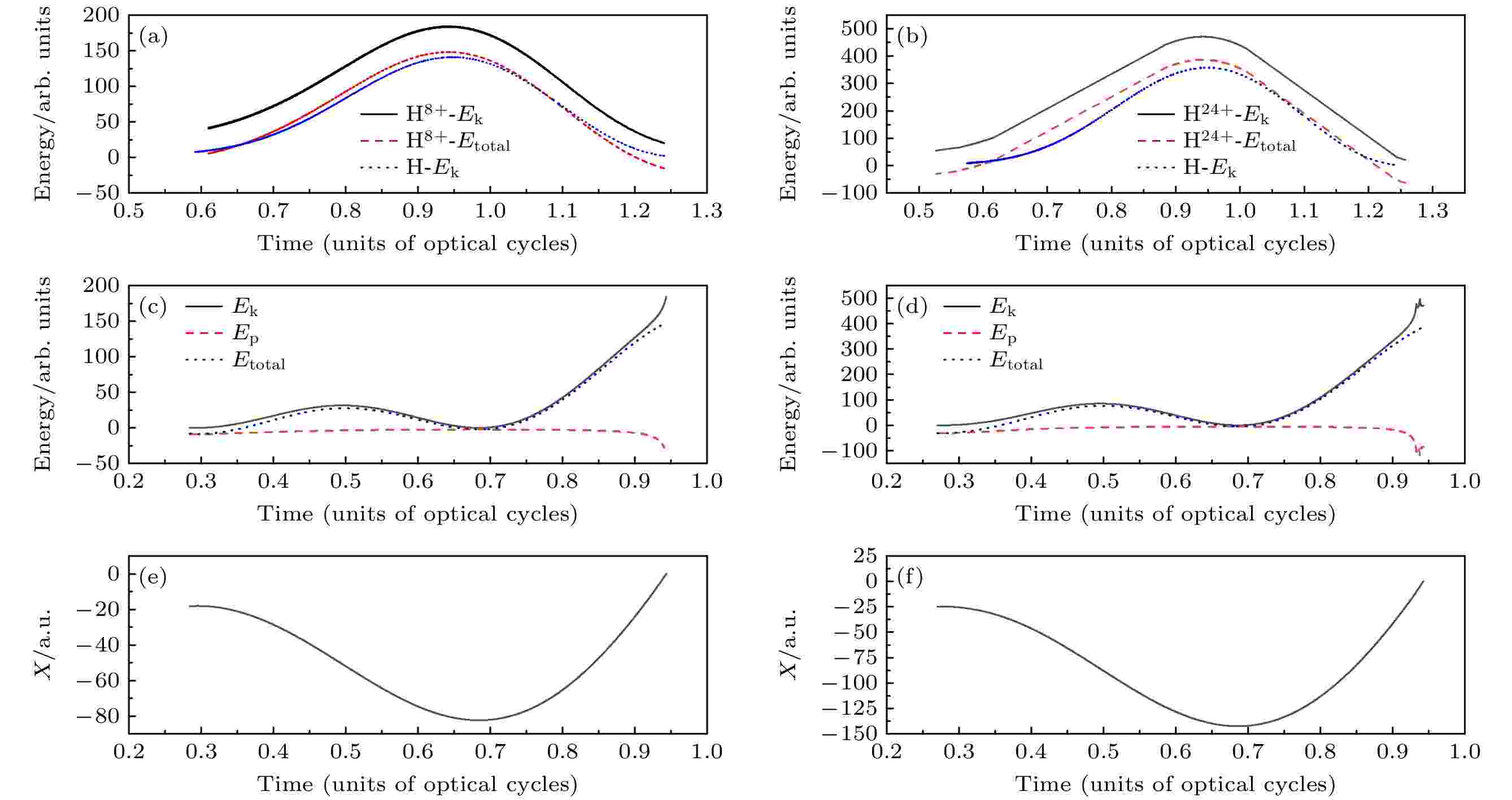
2023, 72 (21): 214203.
doi: 10.7498/aps.72.20230534
Abstract +
By solving the time-dependent Schrödinger equation for the interaction of the intense laser field with the two-dimensional model of H ion cluster, it is found that the high-order harmonic plateau produced by H ion cluster is wider than that generated by a single H atom. The interaction between intense laser field and cluster is decomposed into three processes: internal ionization, classical motion under the action of external field and Coulomb field of the cluster ions, and recombination. After internal ionization, the particle is deemed classical and its motion follows Newton’s equation of motion. By studying the classical trajectory of electron and the variation of kinetic and potential energy with time, it is observed that during the electron’s returning, the additional kinetic energy is required as a result of the reduction in potential energy. Furthermore, the correlation between return energy and return time obtained from the classical model is in good agreement with that obtained from time-dependent Schrödinger equation. In this study, the cutoff energy of high-order harmonic generated by clusters is compared with that of a single atom, indicating that the extension of the platform of high-order harmonic by clusters is primarily caused by the Coulomb effect of other ions surrounding the parent nucleus. Additionally, the influence of ion spacing on the cutoff energy of high-order harmonic is also investigated, and a possible relationship between the cut-off energy of high harmonic and the cluster expansion is established.
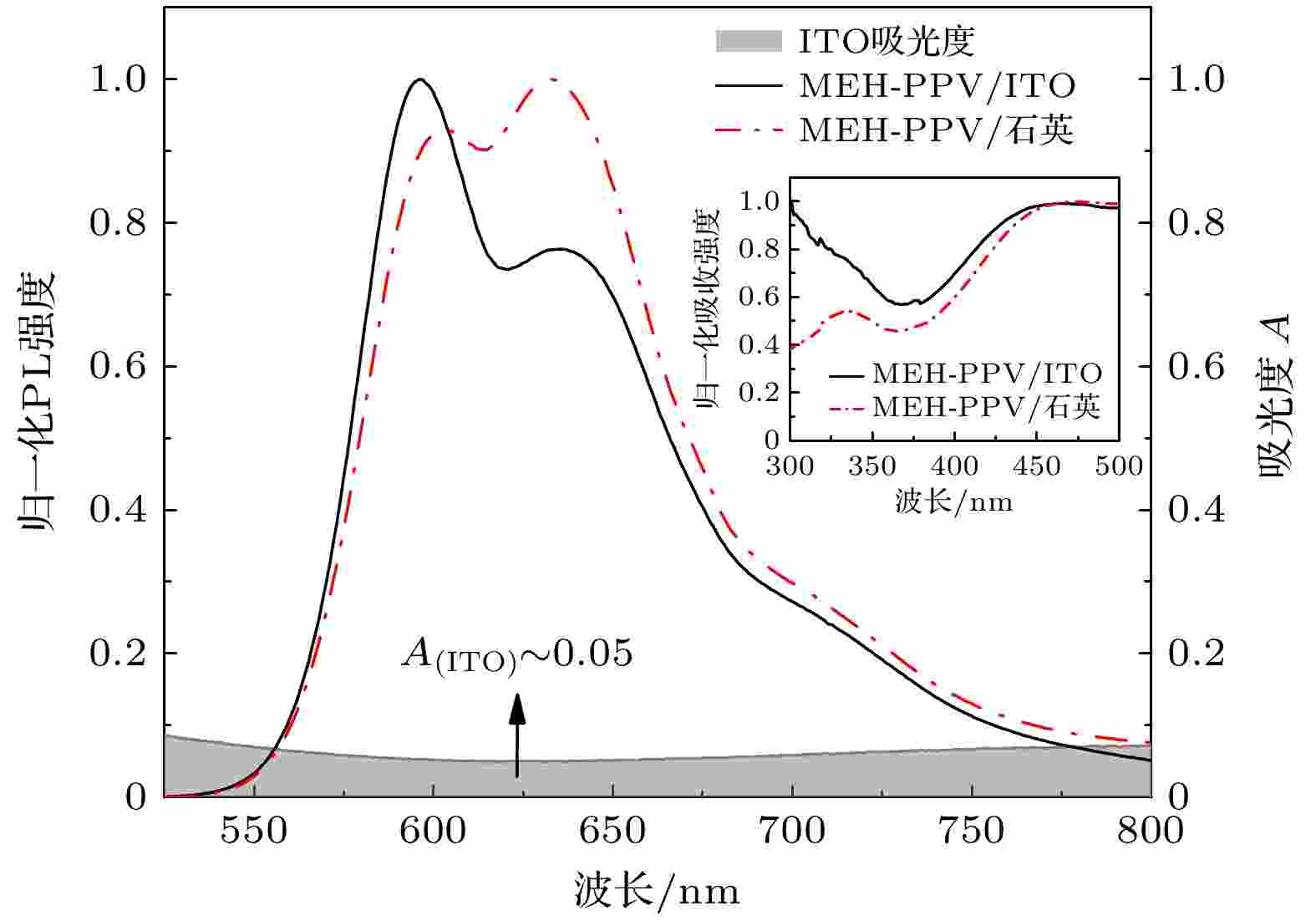
2023, 72 (21): 214204.
doi: 10.7498/aps.72.20230773
Abstract +
In this paper, the optical gain properties of the water/alcohol soluble conjugated polyelectrolyte (Poly[(9,9-bis(3′-((N,N-dimethyl)-N-ethylammonium)propyl)-2,7-fluorene)-alt-2,7-(9,9-dioctylfluorene)]) (PFN-Br) and its potential applications in future electrically pumped organic lasers are revealed and systematically studied. To the best of our knowledge, no studies on the optical gain properties of PFN-Br or its prototype, poly[(9,9-bis(3′-(N,N-dimethylamino)propyl)-2,7-fluorene)-alt-2,7-(9,9-dioctylfluorene)] have been reported before. These conjugated polyelectrolytes are widely used as the interlayers in organic light emitting diodes or organic solar cells. The thickness of such an interlayer is usually less than 10 nm, which is considered not sufficient for supporting light waveguiding. Therefore, the thickness of the PFN-Br layer used in this work is increased to more than 100 nm. Through careful study, the polymer is found to possess a low threshold of amplified spontaneous emission (ASE) (~11 μJ/cm2) and a small ASE cutoff thickness (<50 nm). It is an efficient blue emission (~456 nm) gain medium. The ASE peak of the PFN-Br film is red-shifted as the thickness increases from 50 to 220 nm. By utilizing the great resistance of PFN-Br against the organic solvent, such as toluene, PFN-Br/F8BT bilayer devices on quartz and PFN-Br/MEH-PPV bilayer devices on ITO glass are fabricated and characterized. In the PFN-Br/F8BT bilayer devices, it is found that the PFN-Br interlayer has very limited influence on F8BT. The ASE threshold of F8BT increases only twice, compared with that of F8BT monolayer device, when 100-nm-thick PFN-Br layer is introduced beneath the F8BT film. No significant change in optical gain or loss is observed. Most of the extra losses in F8BT due to the introduction of PFN-Br are attributed to the larger refractive index of PFN-Br than that of quartz substrate. Furthermore, in the PFN-Br/MEH-PPV bilayer devices on ITO glass, introducing PFN-Br interlayer resulting in optimal ASE performance of MEH-PPV compared with that on bare ITO surface. The ASE threshold of MEH-PPV is reduced as much as 60% (from 402 μJ/cm2 to 160 μJ/cm2) while the PFN-Br layer is sandwiched between ITO and MEH-PPV. The PFN-Br layer modifies the waveguiding modes, and reduces the interaction between excitons and ITO electrodes. As a result, the ASE performance of MEH-PPV is improved. The findings of this report indicate that the PFN-Br is not only a good carrier transport material but also a highly-efficient gain medium. PFN-Br, combined with its advantages in different fields, is expected to play various roles in future organic electrically pumped lasers.
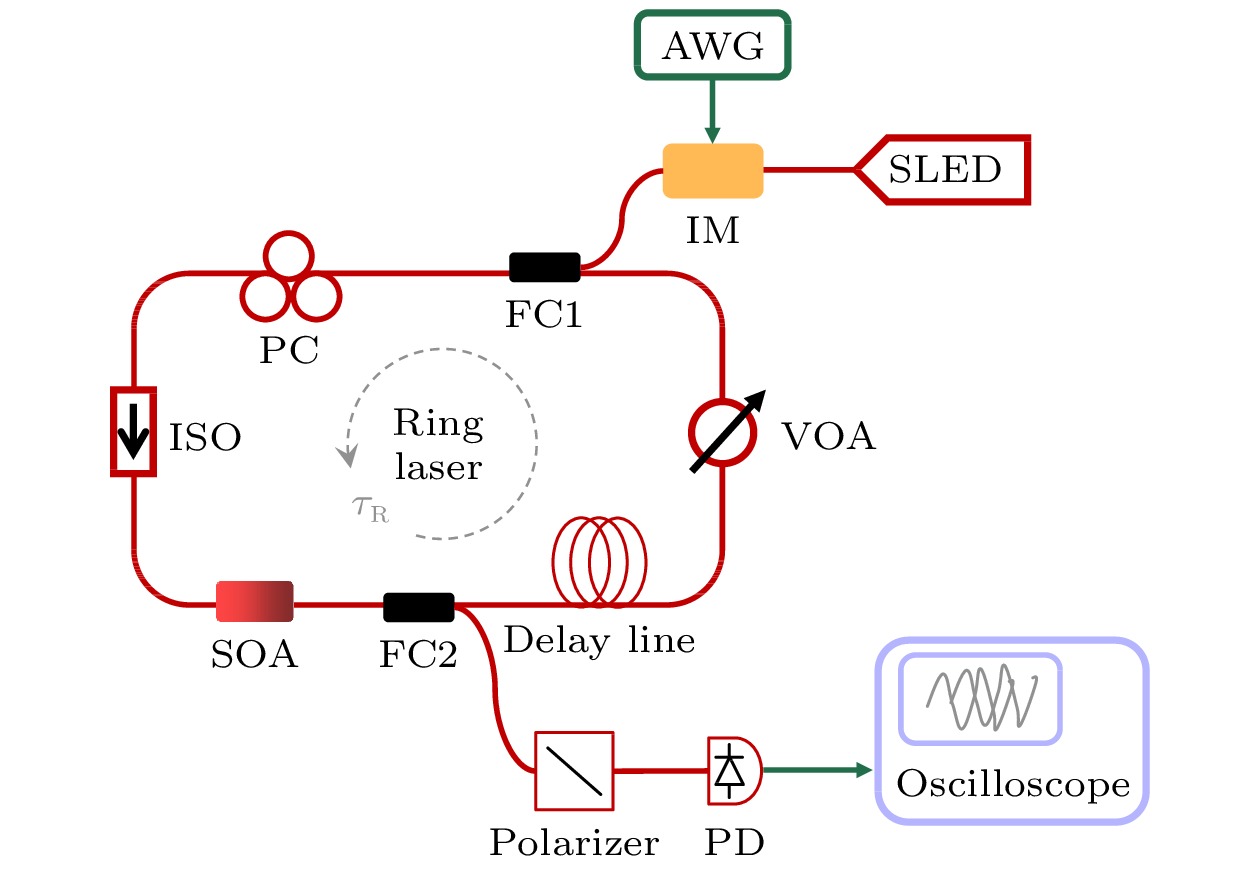
2023, 72 (21): 214205.
doi: 10.7498/aps.72.20230722
Abstract +
Reservoir computing (RC) is a simplified recurrent neural network and can be implemented by using a nonlinear system with delay feedback, thus it is called delay-based RC. Various nonlinear nodes and feedback loop structures have been proposed. Most of existing researches are based on the dynamical responses in intensity of the nonlinear systems. There are also a photoelectric RC system based on wavelength dynamics and an all-optical RC based on the phase dynamics of a semiconductor laser with optical feedback, as well as so-called polarization dynamics of a vertical cavity surface emitting laser (VCSEL). However, these VCSEL-RCs actually are based on the intensity dynamics of two mutually orthogonal polarization modes, or polarization-resolved intensity dynamics. The RC based on rich dynamical responses in polarization has not yet been found. A semiconductor optical amplifier (SOA) fiber ring laser can produce rich dynamical states in polarization, and is used in optical chaotic secure communication and distributed optical fiber sensing. To further expand the application of polarization dynamics of the SOA fiber ring laser and open up a new direction for the research of optical RC neural network, an all-optical RC system based on polarization dynamics of the ring laser is proposed. The ring laser is used as the reservoir, and the SOA as the nonlinear node. After the input signal is masked according to a synchronization scheme, it is injected into the reservoir by intensity modulation for a continuous wave generated by a superluminescent light emitting diode (SLED). The dynamical response in polarization of the ring laser is detected by a polarizer and a photodetector. The influences of the SOA operation current, output power of the SLED and attenuation of a variable optical attenuator (VOA) in the fiber loop on the polarization dynamic characteristic (mainly referring to the output degree of polarization) of the laser are analyzed experimentally. The fading memory and nonlinear response of the RC system based on the polarization dynamic response and intensity dynamic response are compared experimentally. The influences of output power of the SLED and attenuation of the VOA on fading memory, consistency and separation of the RC system based on the two kinds of dynamic responses are investigated experimentally. Thus the range of the VOA attenuation is determined. The network performance of the polarization dynamics RC system is evaluated by processing a Santa Fe time series prediction task and a multi-waveform recognition task. The normalized mean square error can be as low as 0.0058 for the time series prediction task, and the identification rate can be as high as 100% for the recognition task under the appropriate system parameters and only 30 virtual nodes. The experimental results show that the polarization dynamics RC system has good prediction performance and classification capability, which are comparable to the existing RC system based on intensity dynamics of the ring laser. The system can be expected to process two tasks in parallel when the polarization dynamics and intensity dynamics are used at the same time.
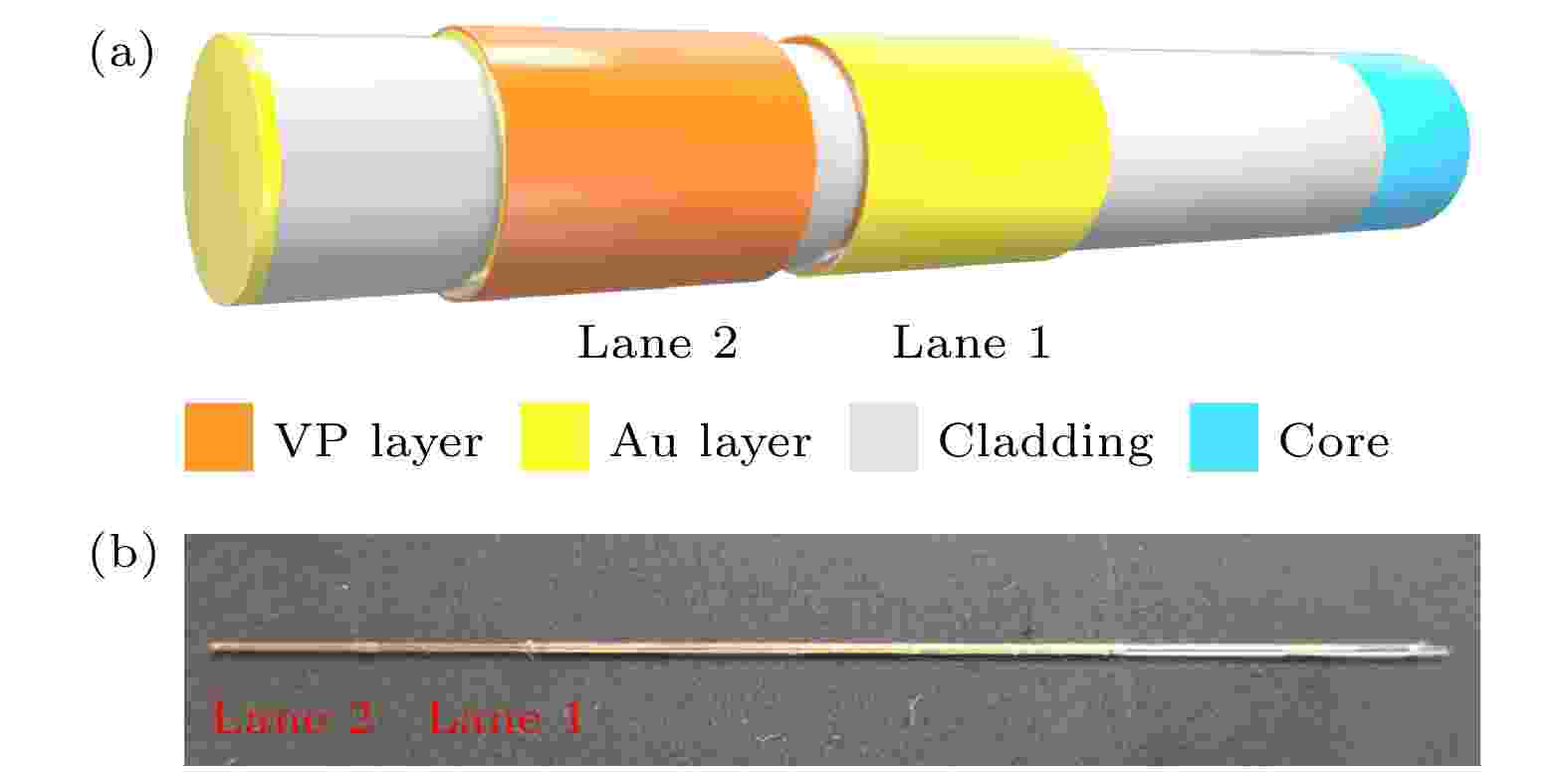
2023, 72 (21): 214206.
doi: 10.7498/aps.72.20231110
Abstract +
The fiber optic surface plasmon resonance (SPR) technologies can directly detect the change of the refractive index on the surface of the sensor, caused by the interaction of biochemical molecules. Fiber optic SPR technologies have advantages of small size, low cost, no labeling, high sensitivity, and are easy to realize the miniaturization, multi-parameter, real-time and in-situ detection. Two types of probe-type fiber optic SPR refractometers are constructed based on the novel two-dimensional nanomaterial, i.e., violet phosphorus (VP), the mature fabrication and characterization technologies. The fabrication processes of the fiber optic SPR refractometers are first introduced, and then the feasibility of the fabrication processes is verified via multiple characterization methods. In terms of the signal demodulation, the noise of the resonance spectrum is suppressed by the variational mode decomposition algorithm, and the resonance wavelength is interrogated and monitored in real time by the centroid method. The refractive index sensing performances of the near-field enhanced fiber optic SPR refractometers coated with different layers of VP are investigated. With the increase of the VP layer number, the resonance spectrum exhibits redshift and broadening and the sensitivity is enhanced. The refractive index sensing performance of the nearly guided wave fiber optic SPR refractometer is also investigated. In the low refractive index range of 1.33-1.34 corresponding to the refractive index of the low-concentration biological solution, the sensitivity and the figure of merit of the near-field enhanced fiber optic SPR refractometer with the sensing structure of fiber core/VP dielectric layer/Au layer/sample layer reach to 2335.64 nm/RIU and 24.15 RIU–1, respectively, which are 1.31 times and 1.25 times higher than the counterparts of the single Au layer fiber optic SPR refractometer, respectively. The sensitivity and the figure of merit of the nearly guided wave fiber optic SPR refractometer with the sensing structure of fiber core/Au layer/VP dielectric layer/sample layer can reach to 2802.06 nm/RIU and 22.53 RIU–1, respectively, which are 1.57 times and 1.16 times higher than the counterparts of the single Au layer fiber optic SPR refractometer. Finally, the near-field enhanced SPR and the nearly guided wave SPR are integrated into a single fiber probe to achieve the double-lane sensing. The fiber optic SPR refractometers developed in this study can realize the high-sensitivity, plug-and-play and double-lane detection of the combination of surface refractive index and volume refractive index. The probe-type refractometer also provides a new idea for detecting multi-type protein molecules and heavy metal ions in the biochemical field.

2023, 72 (21): 214701.
doi: 10.7498/aps.72.20230443
Abstract +
Pulsed electric field is a novel physical energy source for treating atrial fibrillation and tumor ablation, which has advantages over traditional thermal ablation, such as being non-thermal, short treatment time, tissue selectivity, and low contact pressure requirements. The diffusion bubbles generated during physical ablation may lead to gas embolism and silent cerebral events, with potential hazards such as tissue damage and cerebral ischemia. Previous studies have shown that the number of bubbles generated is correlated with the electrical properties of the treated object, pulse parameters (pulse waveform, treatment time and input energy), and electrodes. The number of bubbles are more significant at the cathode than at the anode, and the number of bubbles positively correlates with the input energy. However, to the best of our knowledge, no studies have been conducted to investigate the effects of ablation pulse parameters on diffusion bubbles. Therefore, in our experiment, a platform for producing pulses and observing diffusion bubble is built, and the needle-ring electrode we made realizes the capture and measurement of diffusion bubbles. Since pulses with a voltage of 3 kV and a pulse width of 100 μs are commonly used as ablation parameters for atrial fibrillation and tumor in pulsed field ablation (PFA), the pulse width of unipolar pulse is selected as 5, 10, 50, and 100 μs, and the number of pulses applied is 1. The pulse voltage is determined according to the parameters commonly used in PFA and the simulation calculation of the field strength distribution of the needle-ring electrode. After determining the parameters, this experiment explicitly investigates the relationships among diffusion bubbles and solution conductivity, pulse voltage, pulse width, input energy, and other parameters. Meanwhile, the size distributions of diffusion bubbles under different operating conditions are statistically investigated. Besides, the possible causes of diffuse bubbles are also explored. We evaluate the number of bubbles by measuring the cross-sectional area of the diffusion bubbles from a top-down perspective. The experimental results show that the area of diffusion bubbles generated in the liquid is positively correlated with pulse voltage and input energy; high conductivity and long pulse width can enhance the thermal effect and increase the area of diffusion bubbles; diffusion bubbles with a diameter larger than 100 μm are easily generated under high conductivity and high pulse width conditions. By speculating on the results, the electrolytic reaction may be the main source of diffusion bubbles when the needle electrode is the cathode. This study is expected to optimize future pulsed electric field ablation parameters.
PHYSICS OF GASES, PLASMAS, AND ELECTRIC DISCHARGES
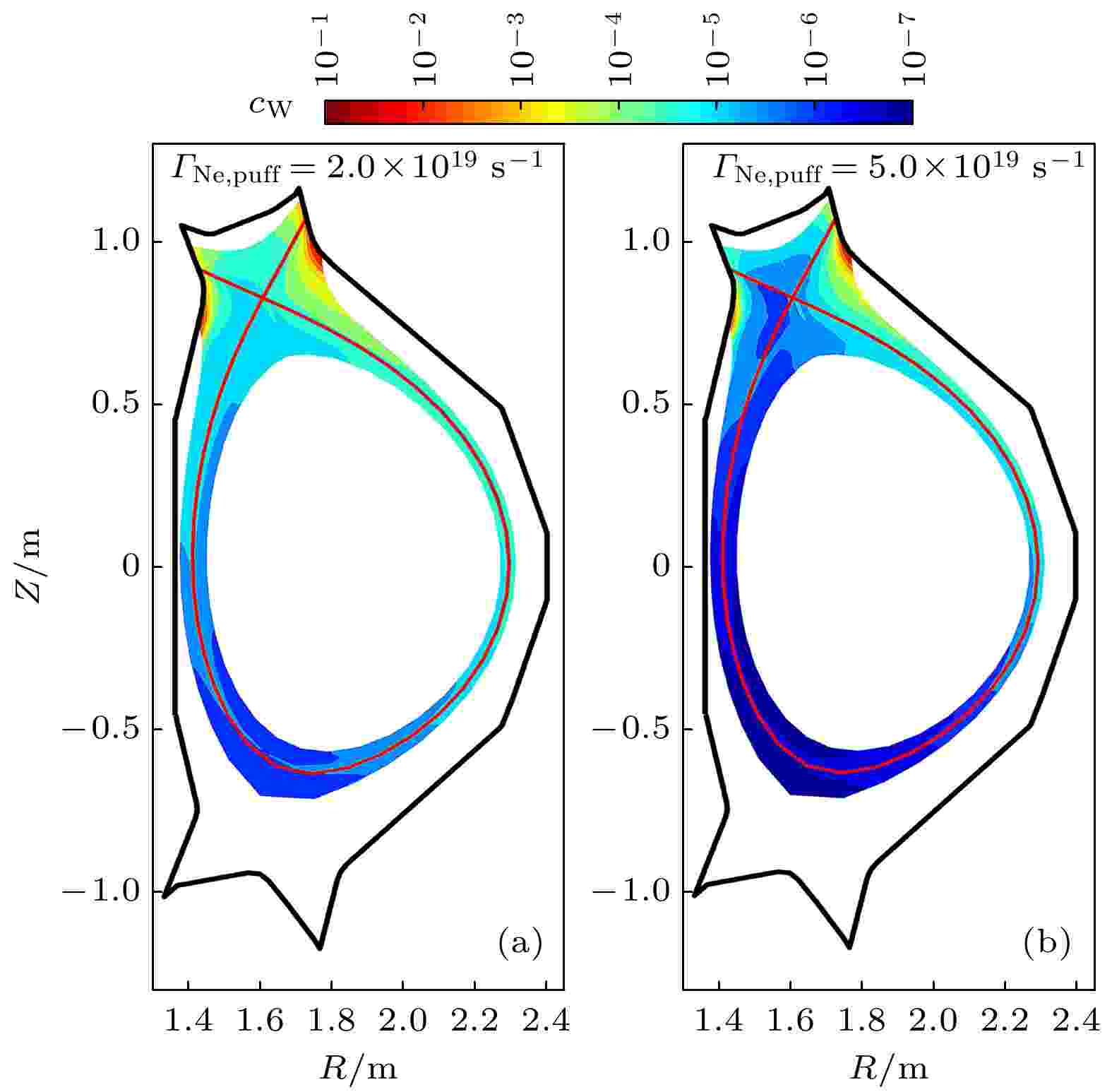
2023, 72 (21): 215213.
doi: 10.7498/aps.72.20230991
Abstract +
Accumulation of tungsten (W) in core is a serious challenge for achieving high-performance plasmas in future tokamak reactors, thus W impurity transport is a highly concerned topic in the tokamak physics researches. Multi-fluid model and kinetic model are the numerical tools widely used for investigating and/or predicting impurity behaviors in the boundary of tokamak plasma. Generally, the applicability of multi-fluid model for impurity transport modeling requires that the collision mean-free-path should be smaller than the gradient scale lengths of particles, which may not be always satisfied. It is performed and comparatively investigated to evaluate the applicability of multi-fluid model for W impurity transport modeling, multi-fluid (SOLPS-ITER) modeling and kinetic (DIVIMP) modeling of W impurity transport in the edge of high-confinement plasma in Experimental Advanced Superconducting Tokamak (EAST) during neon impurity seeding. It is found that low-charge-state W ions are mainly located in the divertor region near the target plate where plasma collisionality is relatively high due to the relatively low/high local plasma temperature/density. Hence, the fluid assumption for transport of lowly-charged W ions can be well satisfied. Consequently, the density of lowly-charged W ions predicted by SOLPS-ITER and that calculated by DIVIMP are almost similar. Owing to the fact that the density of highly-charged W ions is relatively low and these particles mainly exist in the upstream (e.g. the main SOL and core) where plasma collisionality is relatively low, the fluid approximation cannot be well satisfied. However, the total W impurity density calculated by the kinetic code DIVIMP and the multi-fluid model SOLPS-ITER are found to be in agreement with each other within a factor of 1.5 for the simulation cases presented in this contribution. Besides, the multi-fluid simulation with bundled charge state model has also been performed, the obtained results are compared with those from the multi-fluid modeling with W ions treated as 74 fluids. It is revealed that in simulation cases with neon impurity seeding and with divertor plasmas in high-recycling or partially detached regimes, the bundling scheme, which is commonly used for saving the computation cost in multi-fluid modeling, tends to overestimate the average charge state of W ions and thus tends to underestimate the radiation power loss, especially in the divertor region. Consequently, under the circumstance that W impurity radiation dominates the radiative power loss in divertor region, plasma temperature/density can be largely overestimated/underestimated, leading to the underestimation of W ion ionization source and W impurity density. Moreover, simulation results demonstrate that W accumulation in core can decrease effectively during divertor detachment promoted by neon seeding.
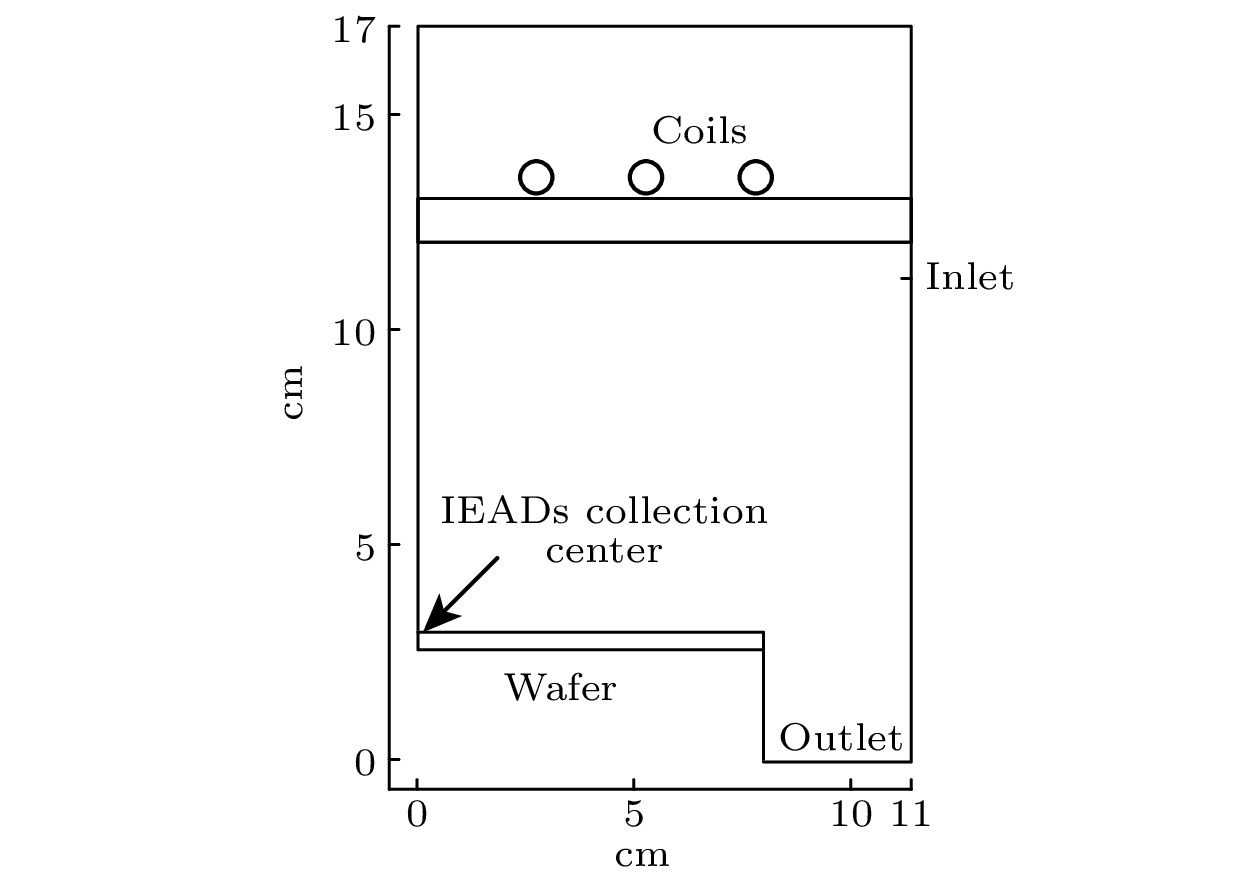
2023, 72 (21): 215214.
doi: 10.7498/aps.72.20231022
Abstract +
With the shrink of critical dimensions of semiconductor devices to a few nanometers, atomic layer etching (ALE) has become an important technique to achieve single-atom resolution. The ALE can divide plasma etching into two self-limiting reaction processes: passivation process and etching process, allowing for the sequential removal of material atomic layer by layer. Therefore, it encounters the problem of low etch rate. In this work, the variation in surface substance coverage during the passivation process and the etching process are investigated numerically to optimize both the passivation duration and the etching duration. A coupled model integrating a two-dimensional inductively coupled plasma discharge chamber model, a one-dimensional sheath model, and a three-dimensional etching trench model is developed and used to investigate the optimal time for one single cycle ALE of silicon through the use of Ar/Cl2 gases under the condition of Ar inductively coupled plasma discharge. The results indicate that during the passivation stage, the surface coverage of SiCl and SiCl2 initially increase with time going by and then decrease, while the surface coverage of SiCl3 continuously increases, and eventually, the surface coverage of these three species stabilize. When the surface is predominantly covered by SiCl2, it is the optimal time to trigger the etching process, which induces a relatively favorable surface state and a relatively short etching time. Comparing with typical ALE etching techniques, the time of our optimal ALE single cycle is shortened by about 33.89%. The ALE cycle time (etching rate) exhibits a linear relationship with the aspect ratio. Additionally, the duration of the passivation process and etching process increase linearly with the aspect ratio or etch depth increasing. Moreover, as the etch depth increases, the effect of the passivation process on the ALE rate becomes more significant than that of the etching process.
CONDENSED MATTER: STRUCTURAL, MECHANICAL, AND THERMAL PROPERTIES
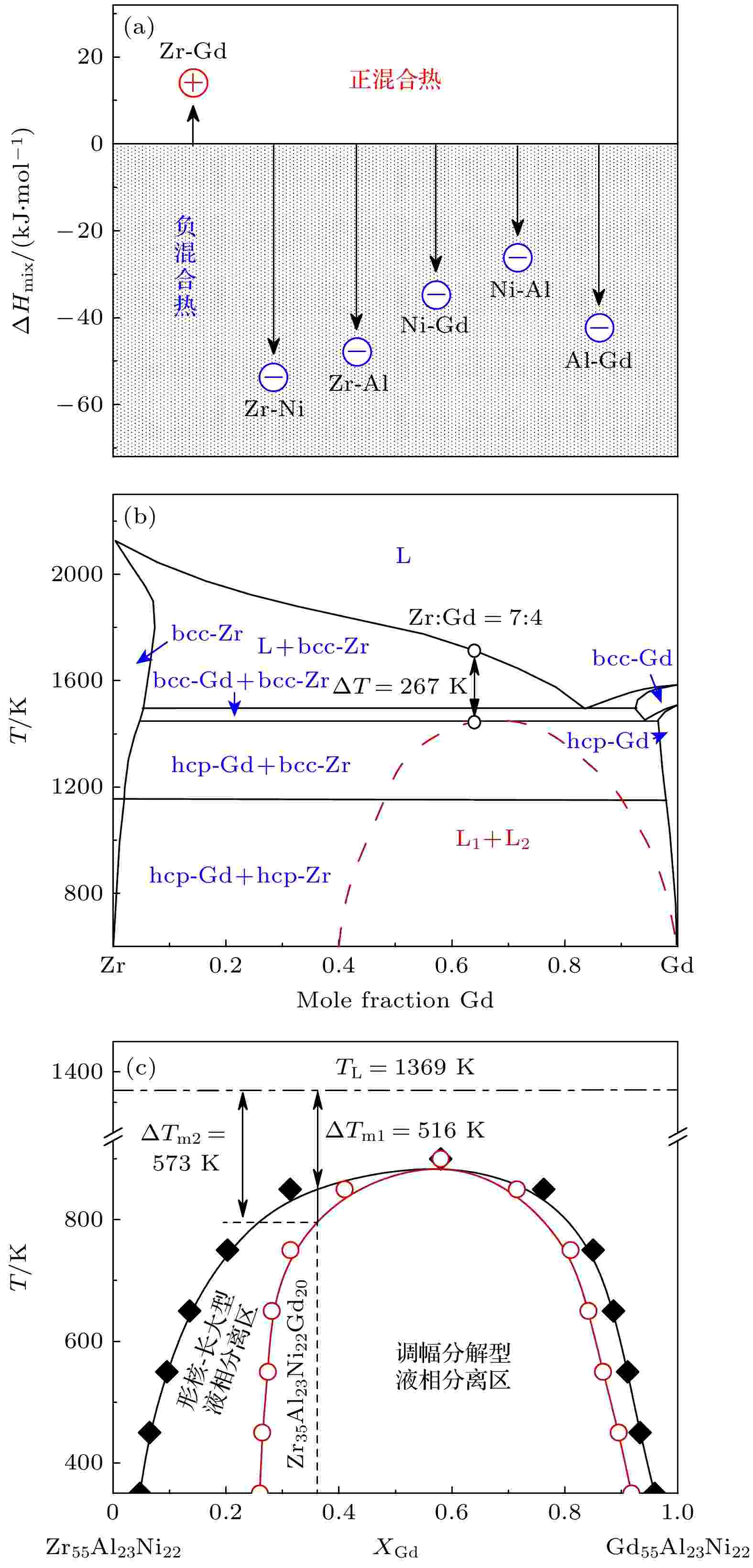
EDITOR'S SUGGESTION
2023, 72 (21): 216401.
doi: 10.7498/aps.72.20231002
Abstract +
Duplex metallic glass with two amorphous phases has been extensively investigated for desirable strength and plasticity. In this paper, the metastable phase separation and dual amorphous phase formation of liquid Zr35Al23Ni22Gd20 alloy under substantial undercooling condition and rapid cooling condition are studied by drop tube technology. The equilibrium solidification structure consists of three crystalline phases, while the critical undercooling temperature of metastable phase separation is determined to be 516 K (0.37TL). The separated Zr-rich liquid phase undergoes amorphous transition and becomes amorphous AM-Zr phase with the composition of Zr45Ni23Al23Gd9 when alloy undercooling is increased to 624 K (0.45TL). After that, the Gd-rich liquid phase forms amorphous AM-Gd phase with the composition of Gd39Al22Ni20Zr19 at larger undercooling of 714 K (0.52TL). With the increase of liquid undercooling and cooling rate, the kinetic mechanism of metastable phase separation changes from nucleation and growth type to spinodal decomposition type, and consequently the microstructure of dual amorphous phases transforms from a spherical morphology to a reticular structure. The average hardness and Young’s modulus, which are influenced by free volume, phase volume fraction and structure of dual amorphous phases, exhibit a complex variation of first increasing and then decreasing with the decrease of alloy droplet size. The formation of dual amorphous phases is in favor of the energy dissipation and the generation of multiple shear bands during mechanical compression, which improves the plasticity for this kind of amorphous alloy.
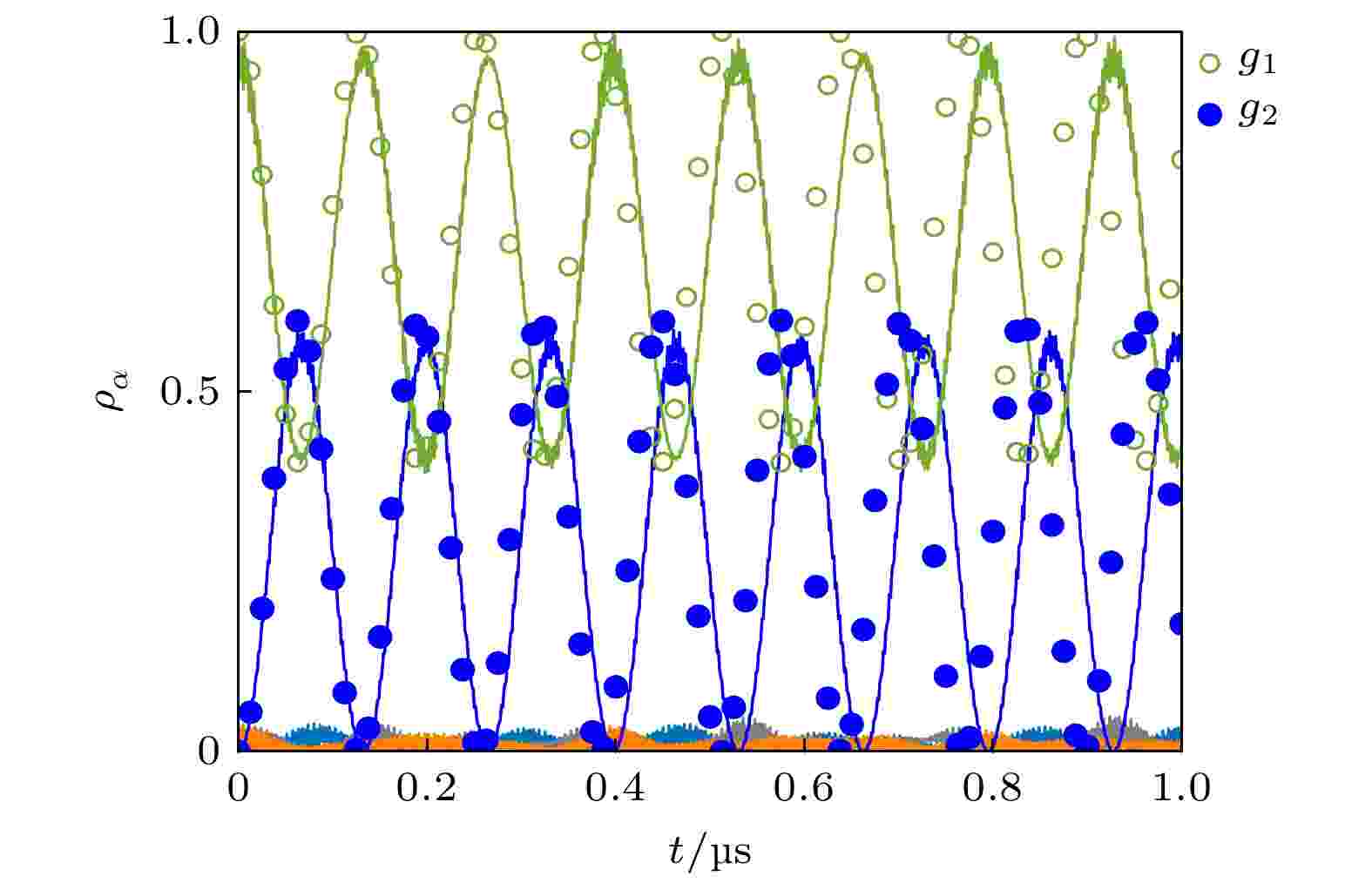
2023, 72 (21): 216701.
doi: 10.7498/aps.72.20231052
Abstract +
In quantum optics, adiabatic elimination simplifies multi-level quantum system by eliminating the fast oscillatory degree of freedom and preserving the slow-varying dynamics, thus obtaining an efficient description of the system. Adiabatic elimination has important applications in quantum simulation and quantum precision measurement. For example, spin-orbit coupling has been realized in ultracold atoms by using three-level Raman coupling and adiabatic elimination. In this paper, we investigate the theoretical method and generalize the adiabatic elimination in three-level non-Hermitian systems and multi-level systems on the basis of standard elimination scheme. These can provide theoretical guidance for realizing the interdiscipline of non-Hermitian physics and spin-orbit coupling effects and their potential applications. We mainly discuss the influences of dissipative effect on the population dynamics of the system, the validity and accuracy of the adiabatic elimination theory under different parameters for both non-Hermitian and two types of five-level systems. Specifically, the dynamics satisfying the large detuning condition gives very accurate results for quite a long evolution time with the adiabatic elimination theory, but when the two-photon detuning δ and the Rabi frequency $\varOmega $ gradually increase, leading to the violation of the large detuning condition $ \varOmega,\gamma, \delta \ll \Delta$ , the effective two-level model can no longer describe the fast-varying dynamics of the system even in a short evolution time. Thus the choice of system parameters affects the effectiveness of adiabatic elimination of the excited levels. In a non-Hermitian system, the population in the ground state oscillates with gain periodically at the beginning, while that in the ground state oscillates with loss and decreases with time, with the total population decreasing with oscillation. For long-time evolution the gain in the system causes the population to diverge, and the adiabatic elimination of the effective two-energy level system describes this behavior accurately. The effect of the non-Hermitian parameters on the dynamics of the system in the resonance case is manifested in the case that the total population remains conserved, while the total population tends to diverge for finite two-photon detuning. We find that with the increase of detuning, the divergence appears earlier and the total number of particles can be kept constant by choosing the ratio of gain to loss appropriately. This study provides a theoretical basis for state preparation and dynamical manipulation in dissipative multi-energy quantum systems.
CONDENSED MATTER: ELECTRONIC STRUCTURE, ELECTRICAL, MAGNETIC, AND OPTICAL PROPERTIES
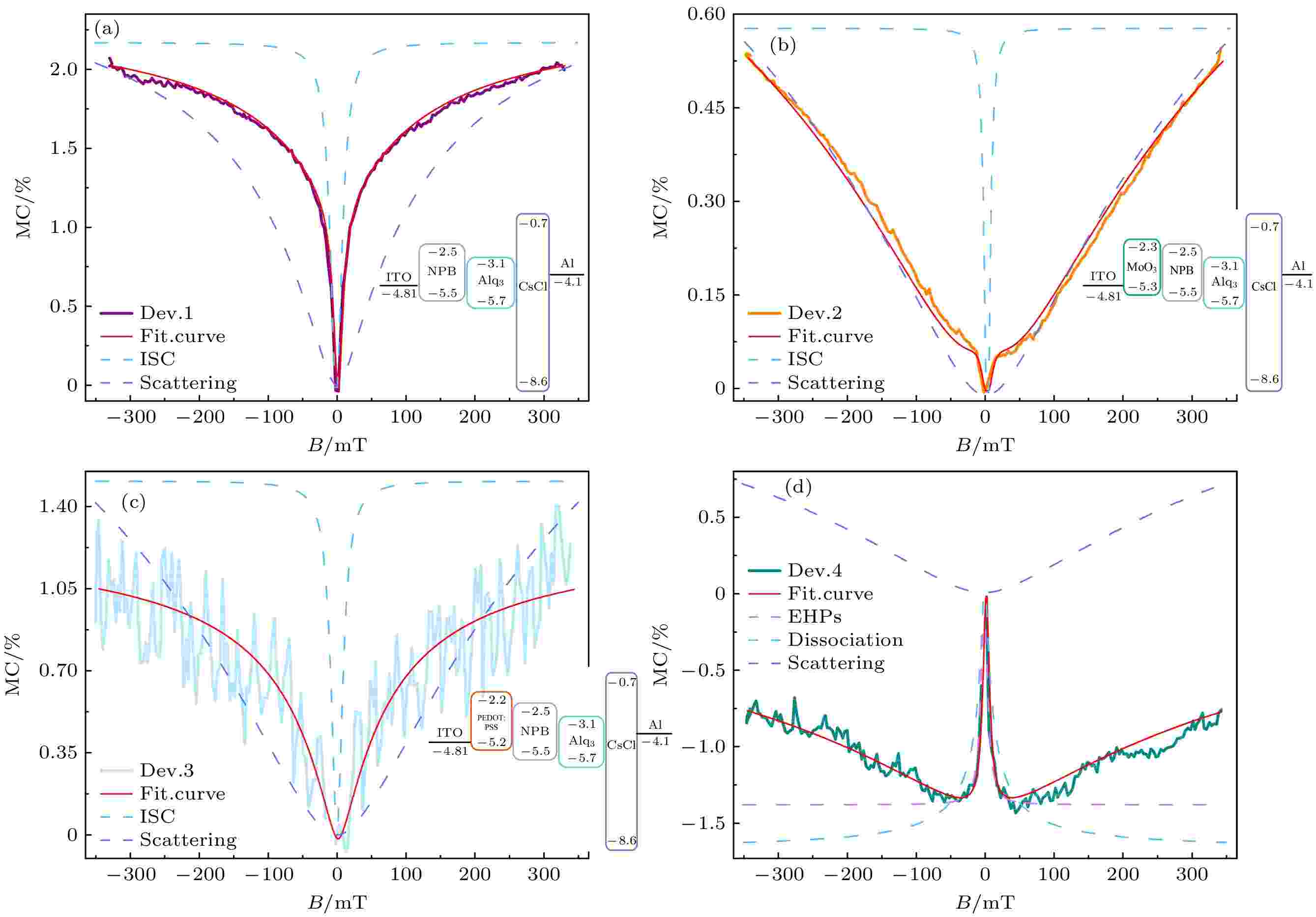
2023, 72 (21): 217101.
doi: 10.7498/aps.72.20230851
Abstract +
Triplet exciton-charge interaction (TQI) has two forms: dissociation and scattering, However, it is still unclear how the hole injection layer affects the dissociation and scattering of triplet excition and the transition between positive and negative values of magneto-conductance (MC). In this paper, HAT-CN, which can produce carrier ladder effect, is used as hole injection layer (HIL), and magnetic effect is used as a tool to study it. The results show that there are three characteristic magnetic fields in the device: hyperfine, dissociation and scattering, which are verified by fitting the MC with Lorentzian and non-Lorentzian functions. The hyperfine characteristic magnetic field results from the magnetic field suppressing superfine field-induced charge-spin mixing. With the enhancement of magnetic field, hole injection layer/hole transport layer interface produces carrier ladder effect, which improves the hole injection efficiency. The triplet excitions are separated by the hole, then the secondary carriers are produced, which makes the device’s luminous brightness and efficiency reach to 43210 cd/m2 and 9.8 cd/A, respectively. The carrier ladder effect will also lead to a large accumulation of injected charges, resulting in the scattering of charge carriers by triplet excition, thereby reducing their mobility, which is not conducive to the formation of excited states nor device luminescence. The MC is modulated by KS/KT (recombination rate ratio), and when the electric field is small $ {K}_{{\rm{S}}}\gg {K}_{{\rm{T}}} $ , the recombination ratio is relatively large, resulting in positive MC. With the increase of electric field $ {K}_{{\rm{S}}}\approx {K}_{{\rm{T}}}=K$ , KS/KT approaches 1 at this time, resulting in an MC, which is negative in a low temperature environment. This work provides a novel approach for regulating and effectively utilizing triplet excitons.
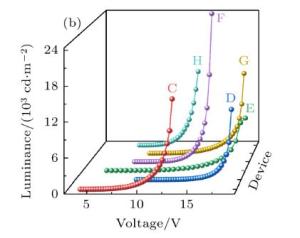
2023, 72 (21): 217201.
doi: 10.7498/aps.72.20230973
Abstract +
Tandem organic electroluminescent devices (OLEDs) have attracted widespread attention due to their long lifetime and high current efficiency. In this study, a double-emitting unit tandem OLED is fabricated by using Alq3/HAT-CN as an interconnect layer. Its photovoltaic properties and exciton regulation mechanism are investigated. The results show that the luminance (11189.86 cd/m2) and efficiency (13.85 cd/A) of the tandem OLED reaches 2.7 times that of the single electroluminescent (EL) unit OLED (luminance and efficiency of 4007.14 cd/m2 and 5.00 cd/A, respectively) at a current density of 80 mA/cm2. This proves that the Alq3/HAT-CN is an efficient interconnect layer. At room temperature, the polaron pair undergoes intersystem crossing (ISC) due to hyperfine interaction (HFI) when a magnetic field is applied to the device. This increases the concentration of the triplet excitons (T1), thus promoting the charge scattering. The result is a rapid increase in the low magnetic field and a slow increase in the high magnetic field of the MEL. When the injection current strength is constant, there is less uncompounded charge in the Alq3/HAT-CN device than in other connected layer devices. Triplet-charge annihilation (TQA) is weak, resulting in a relative increase in the value of T1, which is not involved in the TQA. This suppresses the ISC and leads to a minimal increase in the MEL. As the current strength increases, the T1 value increases, causing TQA to increase and ISC to decrease. Since the TQA is related to charge and T1 value, lowering the temperature reduces the carrier mobility in the device, resulting in the relative decreasing of charge concentration and the weakening of TQA. Lowering the temperature reduces the quenching of thermal phonons and increases the T1 value while extending its lifetime, resulting in the enhancement of triplet-triplet annihilation (TTA). At low temperatures, the high magnetic field shape of the MEL changes from slowly increasing to rapidly decreasing. Therefore, the T1 value can be regulated by varying the current strength and temperature, which further affects the strength of ISC, TQA and TTA, and the luminescence and efficiency of the device can be effectively improved by reducing TQA and ISC. This work is of great significance in understanding the luminescence mechanism of small molecule tandem devices and studying the mechanism for improving their photovoltaic properties.

EDITOR'S SUGGESTION
2023, 72 (21): 217501.
doi: 10.7498/aps.72.20231200
Abstract +
With the rapid development of electronic equipment, electromagnetic interference and electromagnetic radiation pollution have become serious problems, because excessive electromagnetic interference will not only affect normal operation of electronic equipment but also do great harm to human health. In general, an ideal material for microwave absorption with the characteristics of high reflection loss (RL) intensity, wide effective absorption band (EAB), thin thickness, and lightweight could effectively consume electromagnetic wave (EMW) energy. Therefore, it is crucial to search for such an ideal microwave absorption material to deal with the electromagnetic radiation pollution. Two-dimensional (2D) carbon/nitride MXene has received more and more attention in recent years, because excellent electrical conductivity and rich surface-functional groups in MXene show positive effects on electromagnetic wave absorption. However, as a non-magnetic material with only dielectric loss, MXene exhibits obvious impedance mismatch, which greatly limits its practical applications. Combining MXene with magnetic materials becomes a hotspot for the exploration of ideal microwave absorption materials. As a typical ferrite, Fe3O4 shows excellent soft magnetic properties such as high saturation magnetization, high chemical stability, and simple preparation. In this paper, the 2D Fe3O4@Ti3C2Tx composite is successfully prepared by hydrothermal method and simple electrostatic adsorption process. The Fe3O4 nanoparticles are uniformly anchored on the surface of large-sized monolayer Ti3C2Tx, which effectively reduces the stacking of MXene. By regulating the proportion of magnetic materials, the microwave absorption performance of 2D Fe3O4@Ti3C2Tx composite is investigated. With the content of Fe3O4 nanoparticles in the 2D Fe3O4@Ti3C2Tx composite increasing from 4 mg to 8 mg, the microwave absorption performance is enhanced obviously. This is caused by the abundant Fe3O4/Ti3C2Tx interface, scattering channels, point defect, charge density difference in 2D Fe3O4@Ti3C2Tx composite, and the optimized impedance matching. The minimum reflection loss (RLmin) of 2D Fe3O4@Ti3C2Tx composite reaches –69.31 dB at a frequency of 16.19 GHz, and the effective absorption band (EAB) achieves 3.39 GHz. With the content of Fe3O4 nanoparticles further increasing to 10 mg, the microwave absorption performance shows a decreasing trend. Excessive Fe3O4 nanoparticles in the 2D Fe3O4@Ti3C2Tx composite lead to the decrease of electrical conductivity and thus the impedance dis-matching and dielectric loss decreasing, which leads the microwave absorption performance to decrease. Radar scattering cross section (RCS) is a physical quantity that evaluates the intensity of the scattered echo energy in the intercepted electromagnetic wave energy. The results of the RCS simulation can be applied to real objects which have been widely utilized in radar wave stealth. Its multi-angle simulation results can be used as an important basis for evaluating the stealth capability of microwave-absorbing material. The RCS simulations show that the average RCS value of 2D Fe3O4@Ti3C2Tx composite is over –47.92 dBm2 at an incidence angle of 25°, demonstrating its excellent radar wave absorption performance. This study provides new ideas for improving and practically using two-dimensional and magnetic materials in the microwave absorption field and gives a new path to the subsequent development of microwave-absorbing composites.
INTERDISCIPLINARY PHYSICS AND RELATED AREAS OF SCIENCE AND TECHNOLOGY
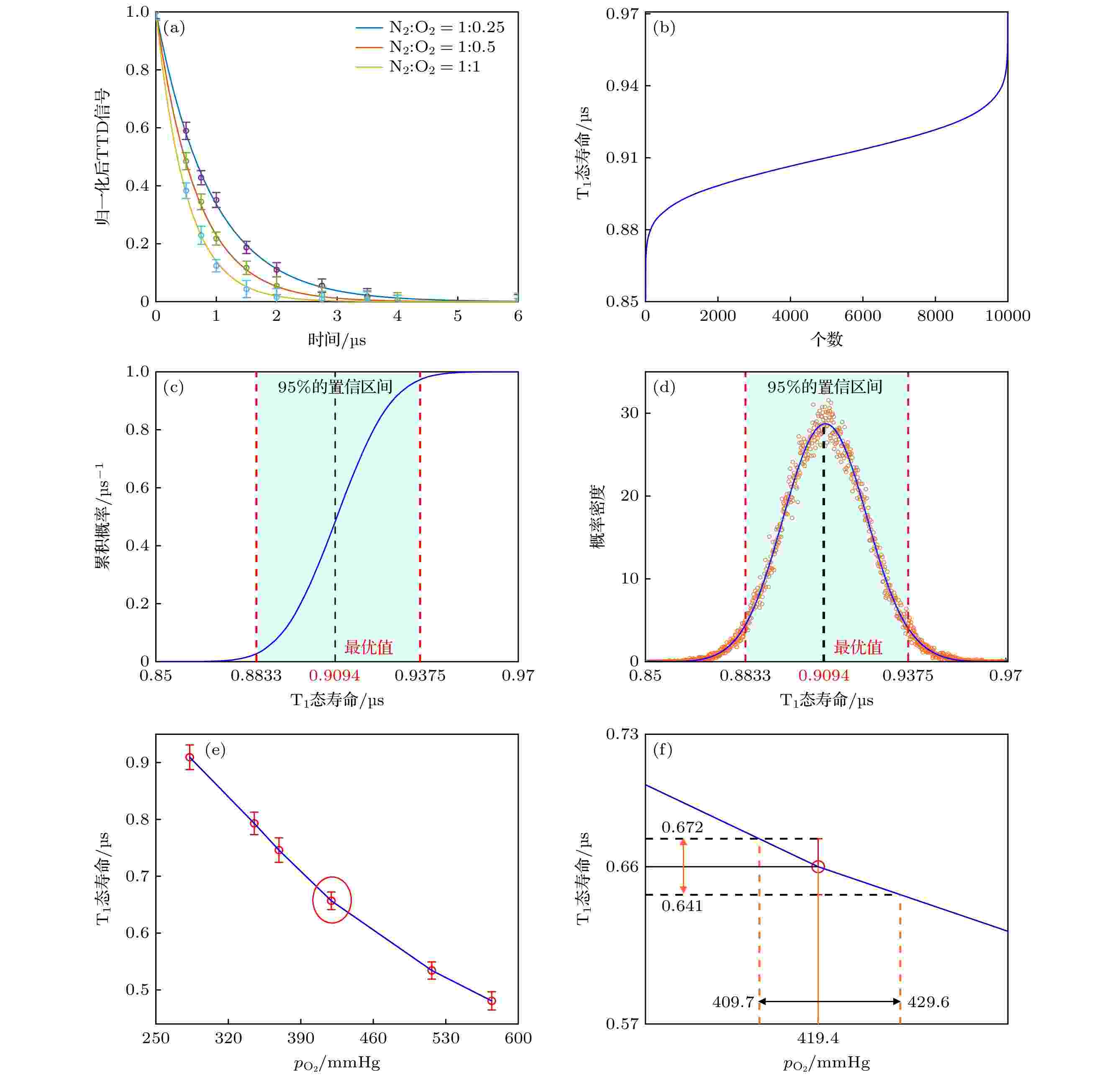
2023, 72 (21): 218101.
doi: 10.7498/aps.72.20231041
Abstract +
Pump-probe-based photoacoustic imaging is an innovative technique for high-specificity molecular imaging in deep tissues. Compared with conventional photoacoustic imaging, this method effectively eliminates the interference from blood signal and other background signal, enabling the detection of subtle target molecules. Additionally, the manipulating of the time delay between the pump laser and probe laser can facilitate non-invasive mapping of oxygen partial pressure distribution within tissues. To quantify the photoacoustic pump-probe imaging, we use methylene blue as the molecular probe to monitor changes in oxygen partial pressure within a hemoglobin solution. Utilizing a Gaussian noise model, we investigate the relationship between the stability of the triplet-state difference signal and the average number, and also evaluate the error associated with measuring oxygen partial pressure. The results demonstrate that the detection accuracy of the system is better than 33 mmHg (1 mmHg = 133 Pa) in the oxygen partial pressure range of about 300 to 550 mmHg after 200 times of averaging. This research will play a significant role in guiding the further advancement and application of pump-probe-based photoacoustic imaging technology.
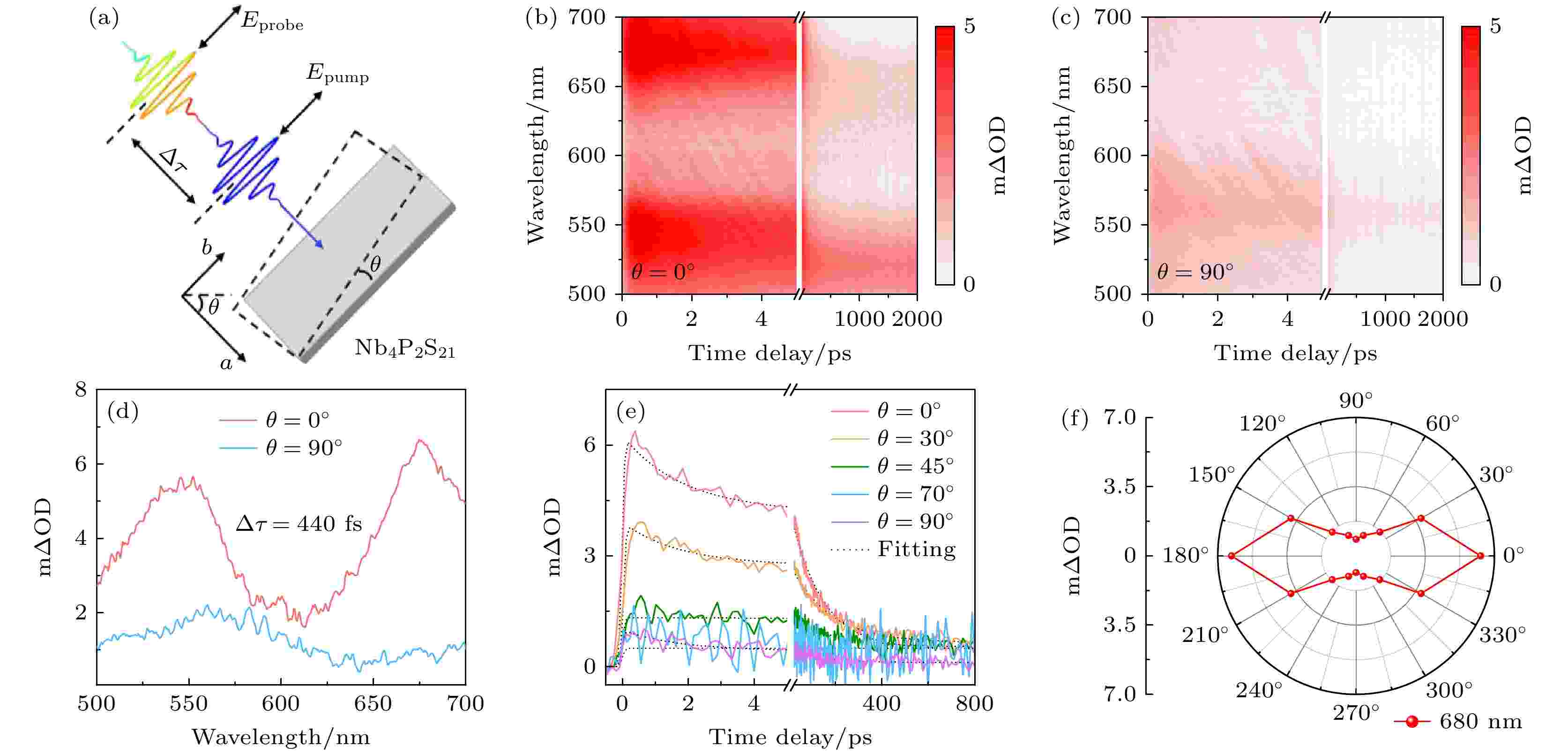
EDITOR'S SUGGESTION
2023, 72 (21): 218102.
doi: 10.7498/aps.72.20231539
Abstract +
Transition-metal phosphorous chalcogenide MPS (M = transition metal), an emerging type of two-dimensional (2D) van der Waals material with the unique optical and opto-electronic properties, has received much attention. The quasi-one-dimensional chain structure of Nb4P2S21 will possess the strong anisotropic optical and photoelectric properties. Therefore, the single crystal and low-dimensional materials of Nb4P2S21 have potential applications in new polarization controllers, polarization-sensitive photoelectronic detectors, etc. However, there is still a lack of research on the anisotropic optical properties of the high-quality Nb4P2S21 single crystals. Herein, the millimeter-sized Nb4P2S21 single crystals are successfully prepared by the chemical vapor transport method. The chemical composition, the crystal structure and the anisotropic optical properties of the Nb4P2S21 single crystals are carefully analyzed. The energy dispersive X-ray spectroscopy results show that the element distribution is uniform and the element ratio is close to the stoichiometric ratio. The X-ray diffraction and the transmission electron microscopy results show a good crystallinity. The absorption spectra shows that the optical band gap of the Nb4P2S21 single crystal is 1.8 eV. Interestingly, the Nb4P2S21 single crystal can be mechanically exfoliated to obtain few-layer material. The thickness-dependent Raman spectra show that the Raman vibration peaks of bulk and few-layer Nb4P2S21 each have only a weak shift, indicating a weak interlayer interaction in the Nb4P2S21 single crystal. In order to make an in-depth study of the optical properties of Nb4P2S21 single crystals, the polarized-dependent Raman spectra and the femtosecond transient absorption (TA) spectra by using pump pulses and probe pulses with a wavelength of 400 nm and a wavelength range of 500–700 nm are recorded. Importantly, the polarized-dependent Raman scattering spectra with the angle-dependent measurements reveal that the intensity of Raman peak at 202 cm–1 and at 489 cm–1 show a 2-fold symmetry and a 4-fold symmetry in the parallel and vertical polarization configurations, respectively. Moreover, the results of ultrafast carrier dynamics with the in-plane rotation angles of Nb4P2S21 single crystals in the parallel polarization configurations, clearly indicate that both the hot carrier number and the relaxation rate after photoexcitation have the in-plane anisotropic properties. These results are useful in understanding the in-plane anisotropic optical properties of Nb4P2S21 single crystal, which can further promote their applications in the low-dimensional angle-dependent optoelectronics.
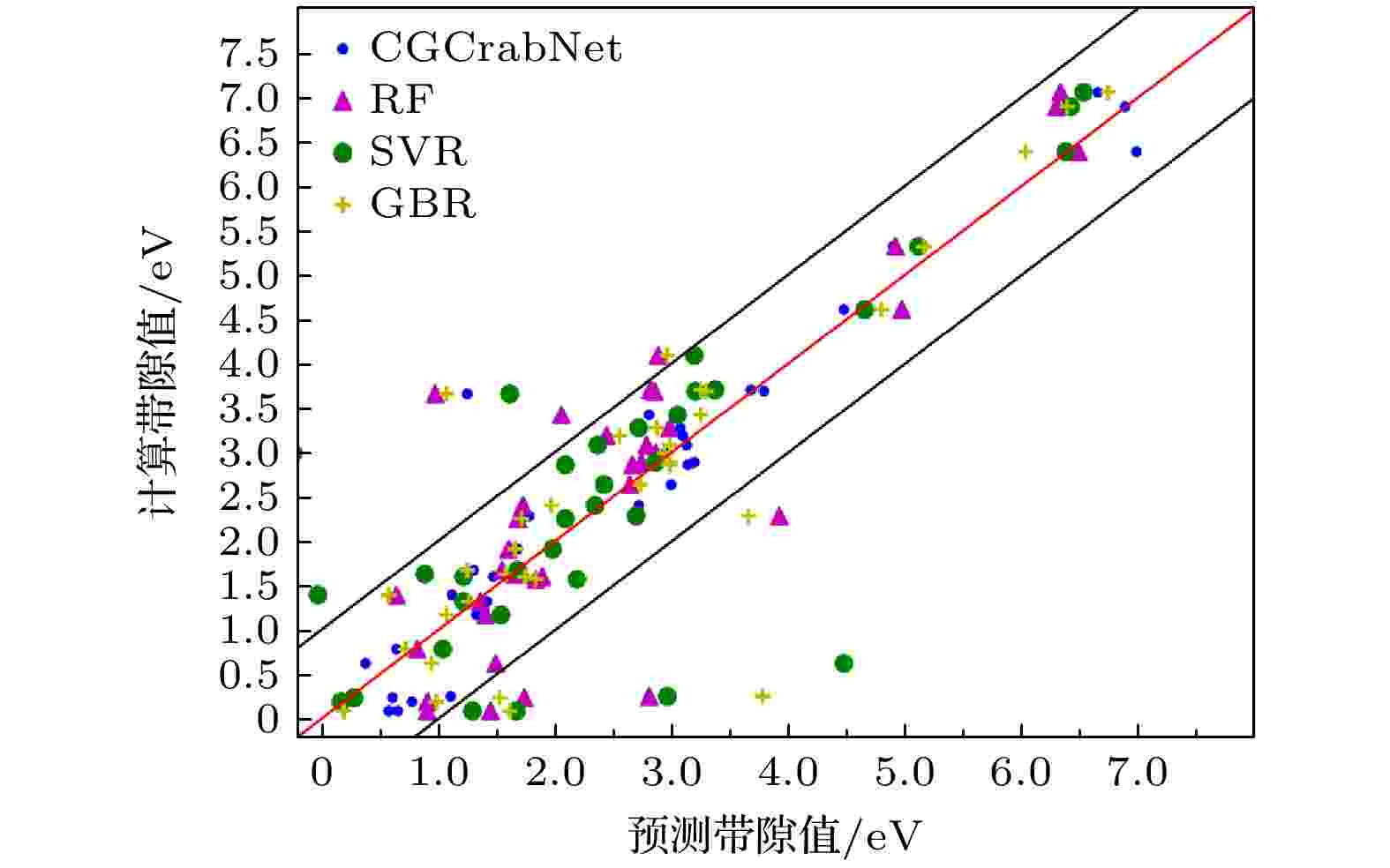
2023, 72 (21): 218901.
doi: 10.7498/aps.72.20231027
Abstract +








